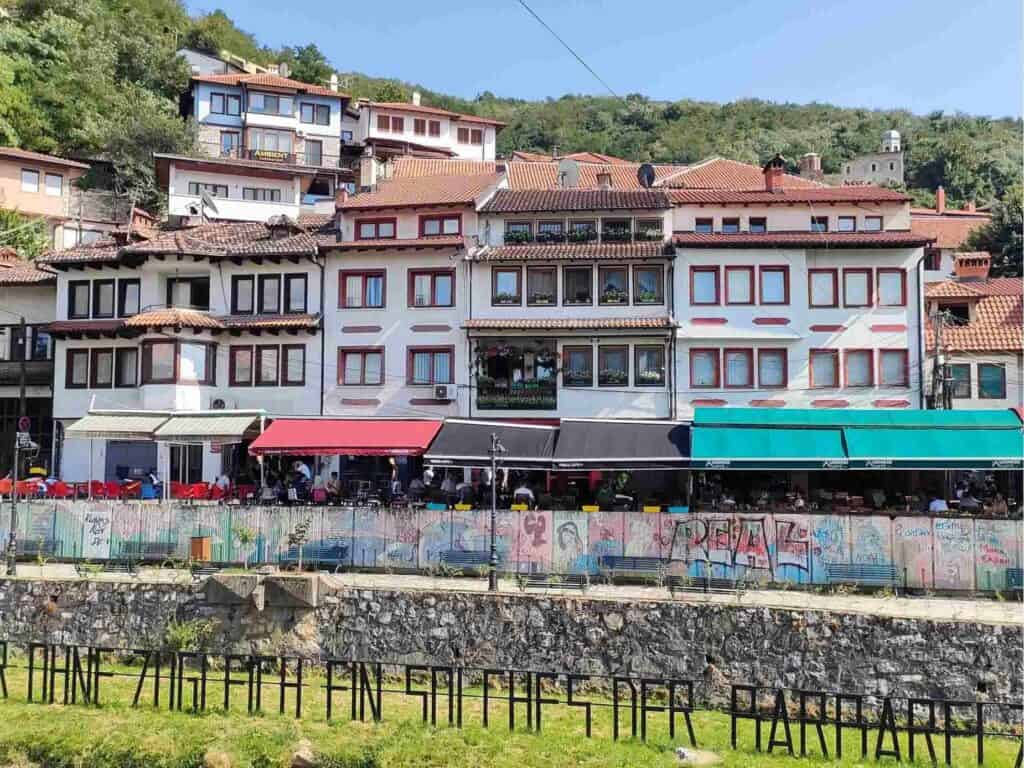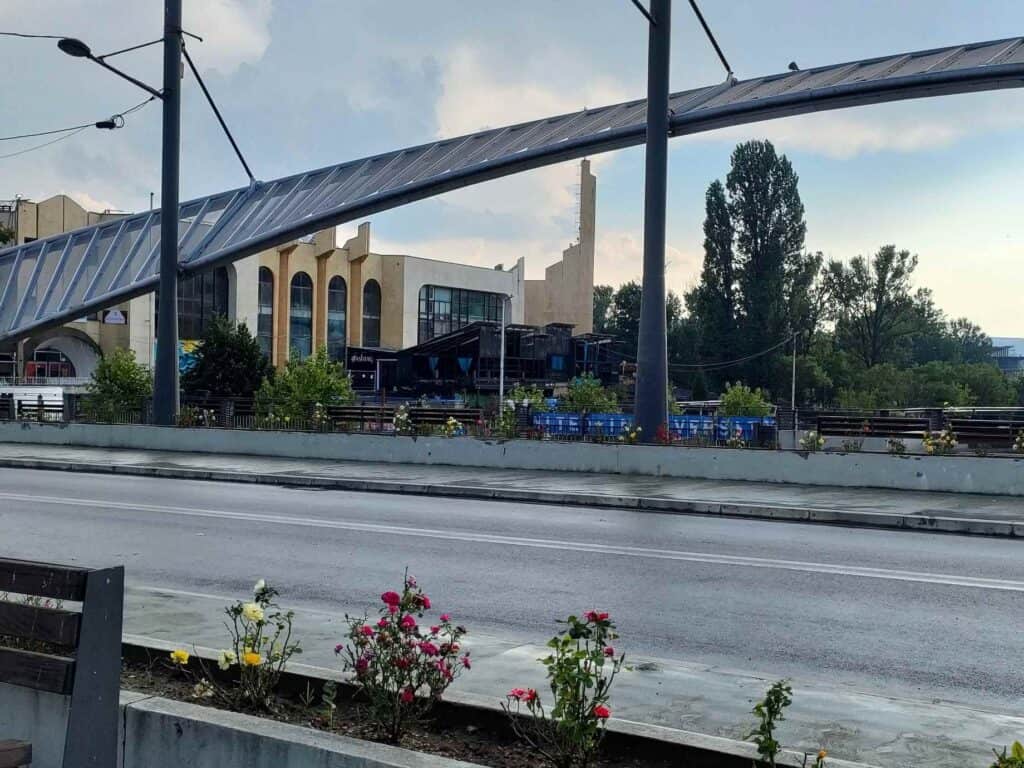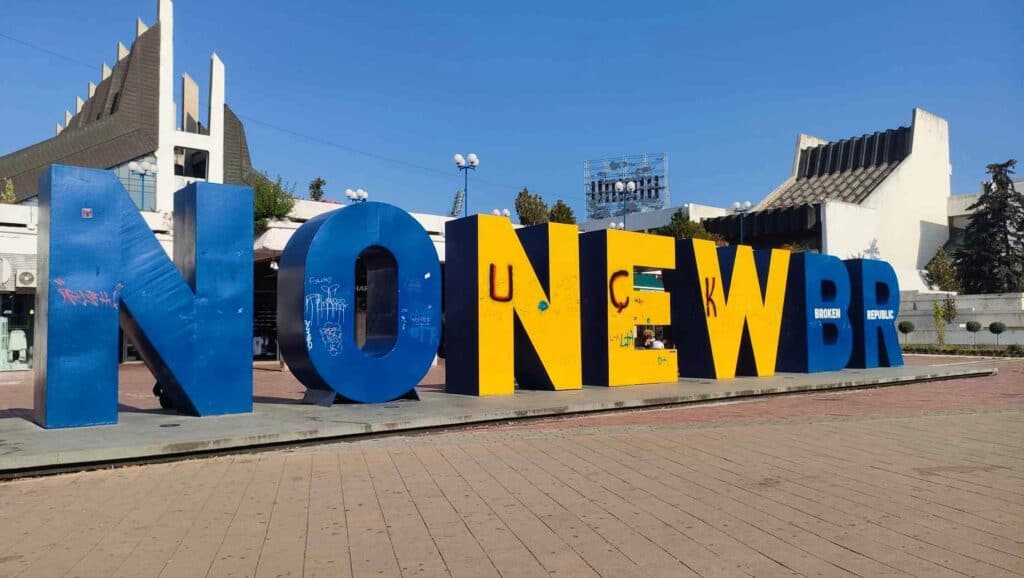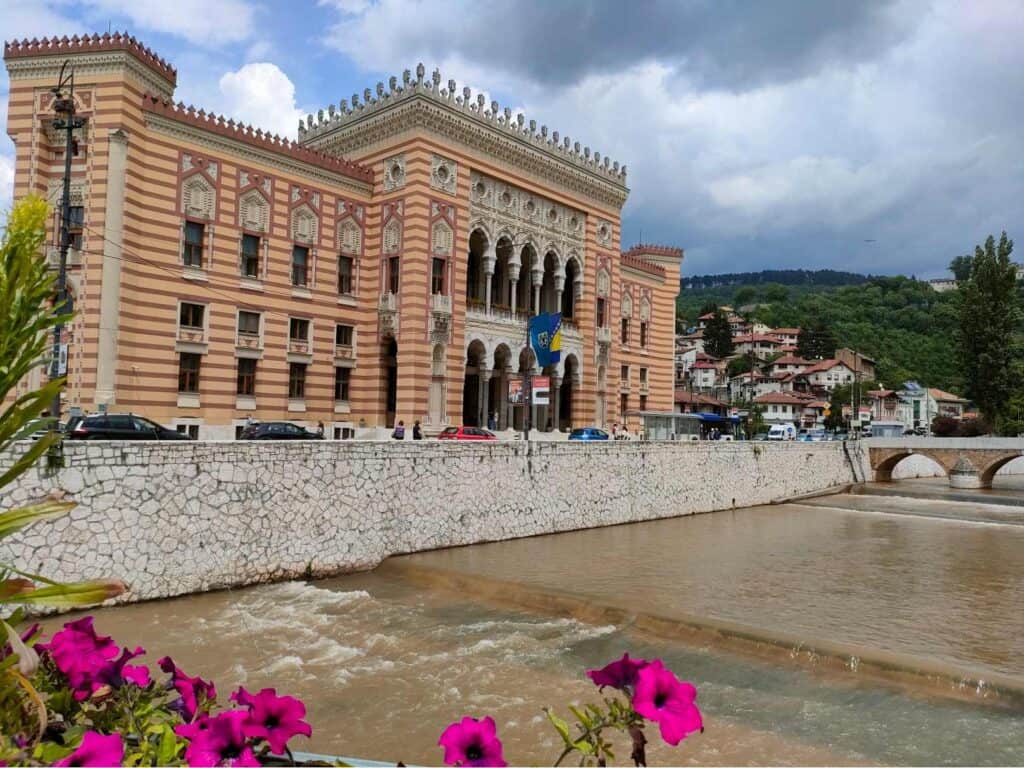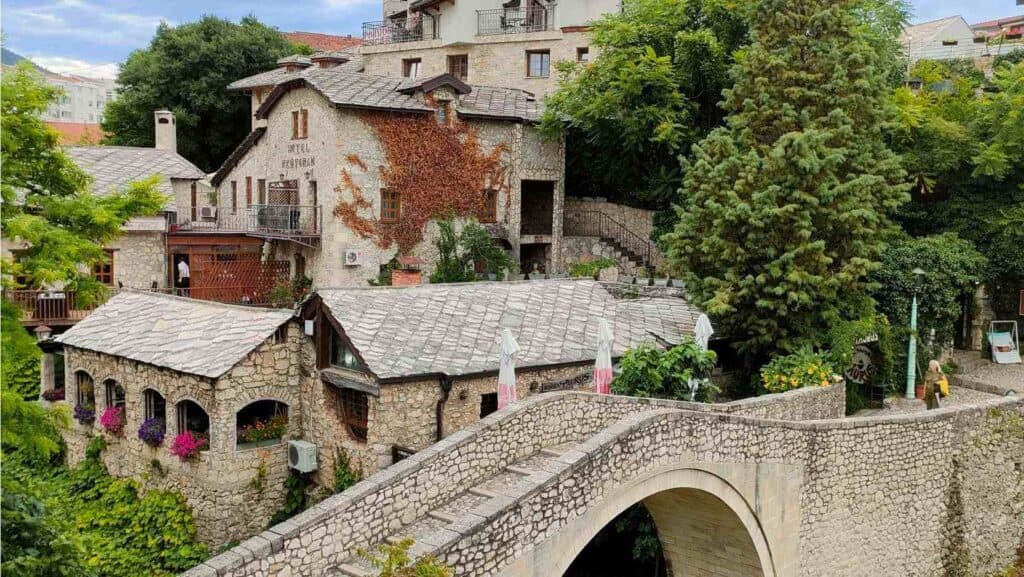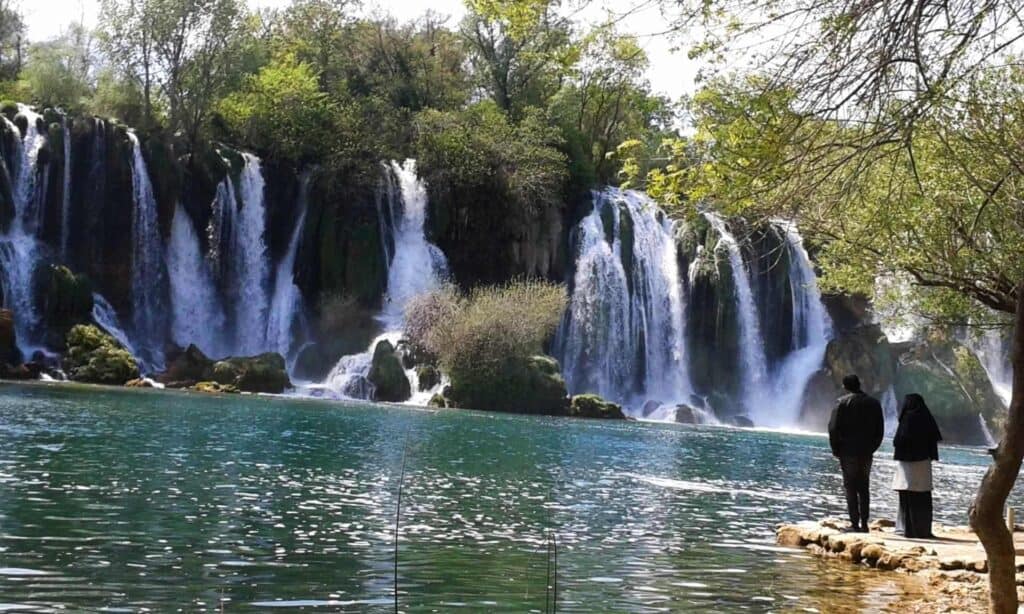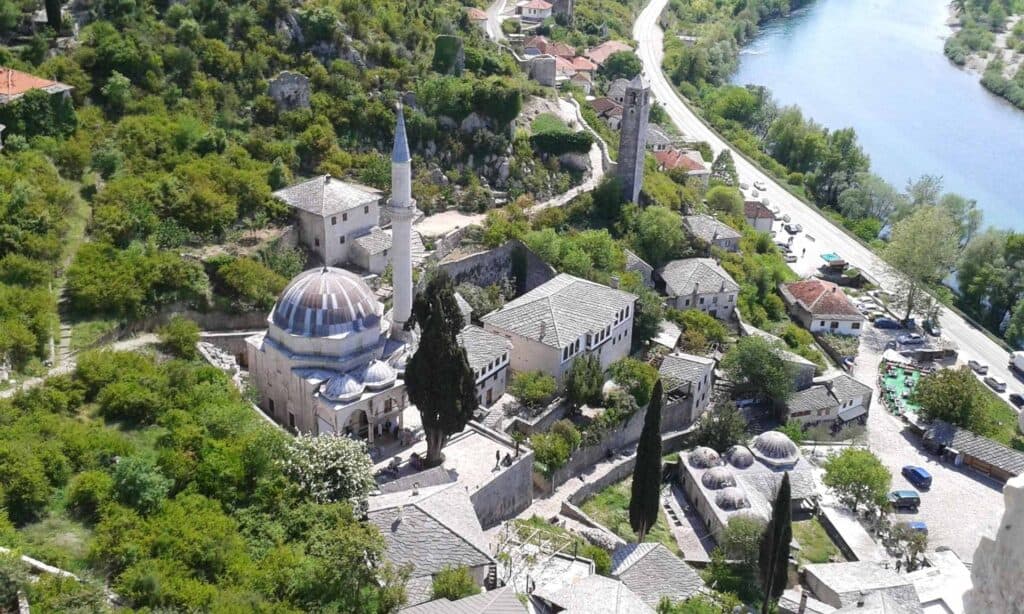This article may contain affiliate / compensated links. For full information, please see our disclaimer here.
Are you planning a trip to Kosovo, one of the least visited destinations in Europe and even in the Balkan? Kosovo is much more than what you hear about it in the media. Unfortunately, it is still mainly associated with the war of the 1990s. But Kosovo has a surprisingly good infrastructure, and the construction of modern buildings in Pristina shows that the country is in progress. But there is still a high percentage of unemployment, around 35 %, for which most, the only way to lead a good life is to move abroad. Apart from historical cities, such as Prizren, Gjakova, and Peja, Kosovo has one of the deepest canyons in Europe, extensive vineyards, and, most importantly, extremely hospitable people. Kosovo has 4 Serbian Orthodox Churches that are part of UNESCO World Heritage, and even if Mitrovica is not the most beautiful city, it is where you can better understand the country. This travel guide contains everything you need to know before planning a trip to Kosovo and a suggested itinerary.
- 6 days itinerary in Kosovo
- How to plan your trip to Kosovo
- What is the best time to visit Kosovo?
- Is Kosovo safe?
- Is Kosovo expensive?
- How to get around with public transport in Kosovo?
- Short history
- The war
- People
- Religion
- Currency
- Language
- What are the best places to visit in Kosovo?
- Pristina
- Prizren
- Visoki Dečani Monastery
- Gjakova
- PEJA/PEĆ
- The Peć Patriarchate
- Rugova Gorge
- Mitrovica, the divided city of Kosovo
- Adem Jashari Memorial Complex
- Rahovec
- Other posts about Kosovo
- Other posts about the Balkan
- Other posts about Kosovo and the Balkan
6 days itinerary in Kosovo
Day 1: Pristina
Day 2: Rahovec, Gračanica Monastery
Day 3: Prizren
Day 4: Gjakova, Visoki Dečani Monastery
Day 5: Peja, Patriarchate of Peć Monastery, Rugova gorge
Day 6: Adem Jashari Memorial complex, Mitrovica
If you want to go hiking in the Rugova gorge, add an extra day to the above itinerary
How to plan your trip to Kosovo
Flight: Find the cheapest flights to Bosnia and Herzegovina with Skyscanner or book flights, hotels, and local tours, rent a car, and benefit from immediate cashback through Wayaway! You can sign up for the Wayaway Membership program for only 49.99$! Use my discount code to get extra 10% off the subscription fee: VOG
Accommodation: Book hostels through hostelworld.com or look for both hostels and hotels in Bosnia and Herzegovina on booking.com.
Local tours: Book walking tours in tours in Sarajevo, Mostar and other one or multi-day trips in Bosnia-Herzegovina through GetYourGuide or Viator
Rent a car: Find a great deal to rent a car with Discover Cars or Rentalcars.
Bus ticket: Book your bus ticket through Bookaway in Bosnia and Herzegovina.
Travel insurance: Safetywing is a popular insurance among travelers that covers almost all countries (except Iran, North Korea, and Cuba). I also use it for my trips.
What is the best time to visit Kosovo?
It was a perfect time to visit Kosovo during the peak season in summer when most Kosovars return to visit family and spend their holidays in their homeland from far away. Cars with foreign number plates were common, most often from Germany. I saw even Maserati or Porsche on the roads of Kosovo. Kosovo is incredibly lively at this time.
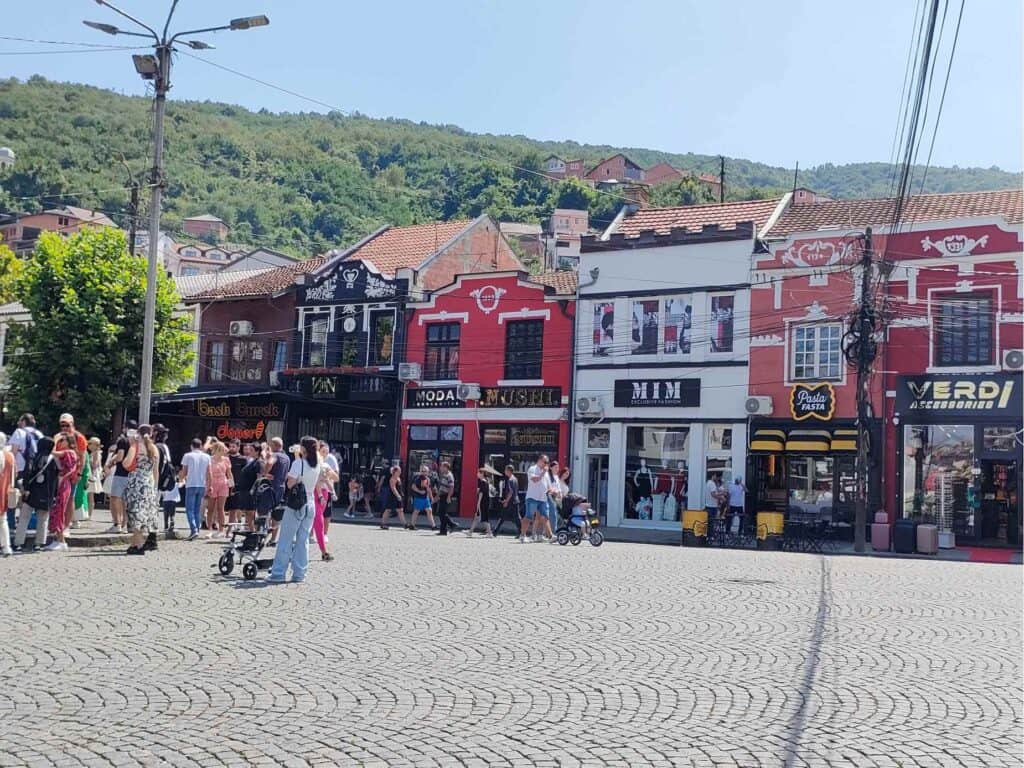
Hundreds of thousands of Kosovars live abroad, mainly in Switzerland, Germany, Austria, and Scandinavia, whose remittances largely contribute to the state’s income (making up 30-40% of the GDP). Many also emigrated to the UK or the United States. It also makes it easy for foreign travelers to get around in Kosovo as quite a few people speak English, German, or sometimes French.
Spring and autumn can also be a good choice as the weather is still pleasant, but summertime is warmer if you also want to go to the mountains. Winters are cold that often come with snow.
Is Kosovo safe?
Although Kosovo is identified with the war of the 1990s, it is safe now, but tensions can rise between Albanians and Serbs. Mitrovica and north Kosovo, where most of the Serb population is concentrated, is the country’s most tense and troubled part. Last time, the election of an Albanian mayor in a Serb-inhabited area led to a clash and the new rule that Serbian number plates are not allowed in Kosovo. As a traveler, you can freely move between the Serbian and Albanian parts of Mitrovica, to the north and south of the Ibar River, but always ask about the situation beforehand.
Read more about safety in Mitrovica in this travel guide.
On 17th March 2004, Serbs clashed with Albanians in Mitrovica after three Albanian boys allegedly drowned in the river Ibar while fleeing Serbs. The media falsely claimed that the incident was ethnically motivated, leaving hundreds of people wounded and almost 20 people dead. The violence spread to other parts of Kosovo and turned into the worst violence between the two ethnic groups since the war. Enraged by the events, Albanians set several Serb monasteries and churches on fire.
Is Kosovo expensive?
Kosovo is a relatively cheap country. First of all, there are hardly any entrance fees; if there are, it is not more than a few euros. A budget accommodation for a private room costs 25-30 Euros. You can probably get one for 20 Euros with a shared bathroom.
Traveling by public transport is cheap; tickets from any city within Kosovo from Pristina cost 2-4 EUR.
A main course in a restaurant costs 7-9 Euros.
Kosovo is a good choice if you are looking for a travel destination in Europe that is affordable and lacks crowds of tourists.
How to get around with public transport in Kosovo?
Getting around by public transport is not the easiest thing in the Balkan. Timetables are not available online, they are infrequent and can change anytime. However, compared to Albania and Bosnia-Herzegovina, it is much easier to get around in Kosovo.
Buses are more frequent, except on Sundays. I planned to go from Pristina to Mitrovica on a Sunday, and there were no buses the whole day. Instead, I headed to Prizren.
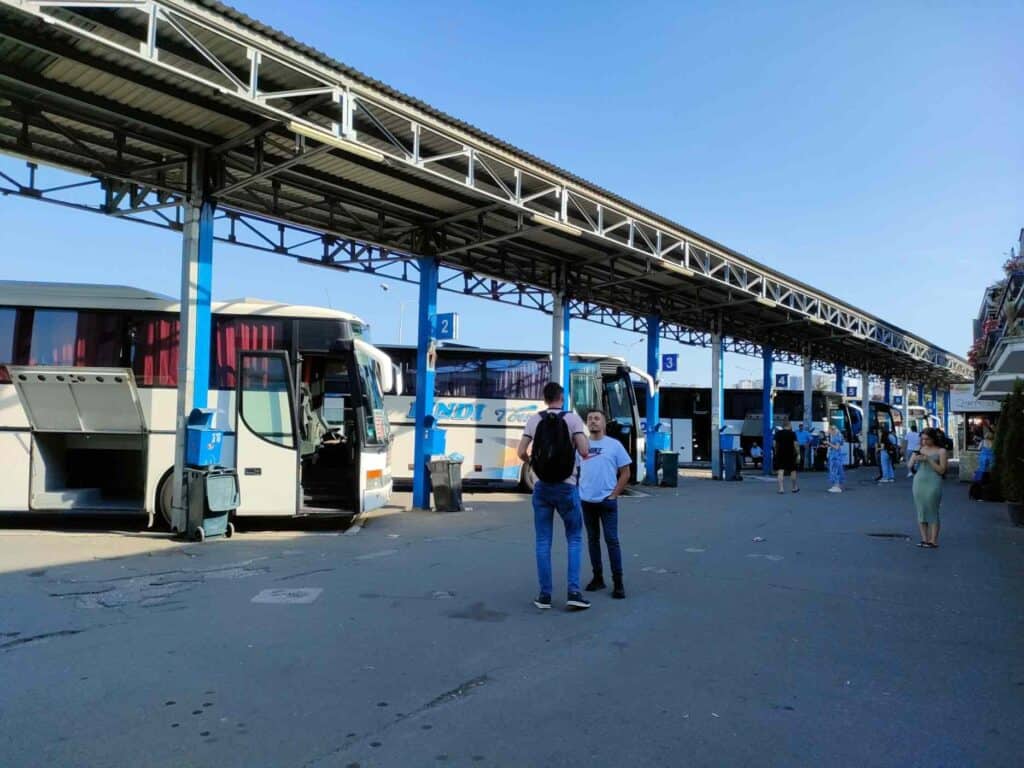
Don’t trust the timetables anywhere in the Balkan, even when you see one at the station. The best is to ask for the departures to your next destination once you are at the station. Sometimes, buses fall out for any reason. Be flexible when traveling in the Balkans.
Kosovo is a small country, and you can visit all the places on a day trip, though it is advisable to stay overnight in the bigger cities to really get the feeling of that.
Short history
Albanians regard Illyrians as their ancestors, who settled long before the Romans. The Slavic Serbs arrived only in the 6th century. Therefore, Albanians say they were first in Kosovo and regard Serbs as invaders. Serbs have a different view of that, stating that although there were some Albanians there already, during medieval times, most of the population was Serbs, and Kosovo was the center of the Serbian Kingdom. Albanians started to migrate in big numbers and became the majority with the arrival of the Ottomans. They support this version with the fact that even the word “Kosovo” has Slavic roots.
Stefan Nemanja founded the Nemanjić dynasty that ruled over Kosovo for over 250 years in the medieval Serbian Empire.
The epic Kosovo Battle of 1389 is one of the most important events in Serbian history that builds the Serb national myth and explains why Kosovo is so important for Serbia. During this battle, Prince Lazar faced the army of the Ottoman Sultan Murad and was defeated. He is considered a martyr who sacrificed his life and gave up his Kingdom for the Serbs. Serbia was under full Ottoman control by the middle of the 15th century.
The Nemanjas also made Kosovo the seat of the Serbian Orthodox, largely defining what it means to be a Serb and making Kosovo its spiritual center.
The myth around the Battle of Kosovo was revived in the 19th century. Since then, it has been an integral part of Serbian history and national pride, eternalized with songs and legends. The modern history of Serbia begins with Kosovo. When the new Serbian state was recognized in 1878 at the Congress of Berlin, it was understood as the revival of the medieval Empire. Kosovo was seen as a mystical place, the symbol of resistance to secularization and modernization, and later to the Albanian demographic threat. After 1945, it was a symbol of resistance to communism itself.
After the fall of the Serbian Empire, Kosovo lived in relative peace and stability as a province within the Ottoman Empire for hundreds of years.
With the disintegration of the Ottoman Empire, Kosovo was the subject of national claims. Serbia and Montenegro gained independence in 1878, but Kosovo remained part of the Ottoman Empire. Nestled between Serbia, Montenegro, and Bosnia and Herzegovina, the latter occupied by the Austro-Hungarian Monarchy since 1878, Kosovo was dragged into the first Balkan War, where Albanians were fighting for their freedom and the unification of all lands inhabited by Albanians. During the Balkan Wars of 1912 -1913, Kosovo and the other Albanian-inhabited lands in Montenegro and Macedonia were lost to the Serbs and Montenegrins. After that, Albanians were destined to live in different countries.
Most of Kosovo became part of the Serbian Kingdom; the Albanians considered it a conquest, while Serbs and others as liberation, although Serbs only made up 30-40% of the total population by then.
The wars at the turn of the 20th century meant that Kosovo remained underdeveloped.
In 1918, Serbia dissolved into the newly formed Kingdom of Serbs, Croats, and Slovenes, later named Yugoslavia, “the land of the South Slavs”. In 1941, the Nazis and Mussolini’s Italy wiped out this state. Most, but not all of Kosovo became part of a Fascist Italian Greater Albania while Serbia reemerged as an occupied state.
Yugoslavia reemerged after WWII as a federation of six republics (Montenegro, Macedonia, Bosnia and Herzegovina, Serbia, Croatia, Slovenia), in which Vojvodina and Kosovo became a province of Serbia that was the largest entity in Yugoslavia.
In 1974, the new Yugoslav constitution redefined Kosovo’s status. It was still part of Serbia but was given almost full autonomy with its own national bank, parliament, government, and police; Albanians even got seats in the Yugoslavian parliament. The Albanians could also open independent schools and universities.
The 1970s was a period of development when Albanian education was possible, the standard of education and health system improved, and large-scale constructions accompanied all that. This is when Pristina turned into a modern city.
Yugoslavia slowly disintegrated after the death of Tito, the former Yugoslav president in 1980, who kept the different ethnicities together. From 1981, the atmosphere changed, and tension between Serbs and Albanians intensified. On the 11th of March 1981, a simple student protest turned into a political one. Albanians demanded a unified Albania and wanted a separate republic within the Federation. A state of emergency was declared, and tanks were on the streets. In the following eight years, hundreds of thousands were questioned. The hostility grew against the Serbs, many decided to leave Kosovo, and by 1991, Albanians were around 80%.
Slobodan Milosevic went personally to Kosovo, at that time only a member of the Communist Party, and listened to the complaints of local Serbs. His words are still remembered as the pre-sign of the war: “No one should dare to beat you.”
The war
Things radically changed when Slobodan Milošević became Serb president, who wanted to establish a Great Serbia, uniting all Serbs in the Balkan in one nation. The Yugoslavian war started when Milošević revoked the autonomy of Kosovo in 1989.
Kosovo Albanians were pushed out of their jobs, schools, and the parliament, and in response, they boycotted state institutions and elections and established parallel education.
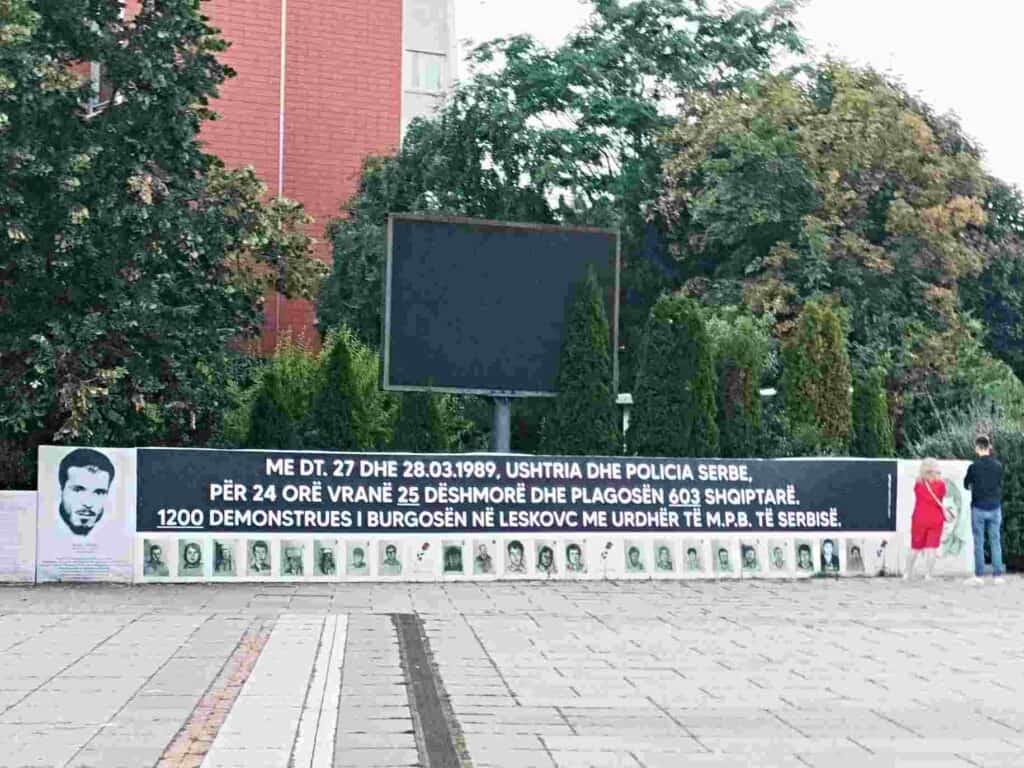
Ibrahim Rugova, elected as president of the self-declared Republic of Kosovo, spoke out for a non-violent struggle for Kosovo’s independence. While he is still admired as the person who did the most to achieve a sovereign Kosovo, later, he was criticized for the same reason, and an armed group, the Kosovo Liberation Army (KLA or UÇK), appeared as a separatist movement that took up arms.
At the beginning of the 1990s, Yugoslavia plunged into a cruel and devastating war. Yugoslavia existed till 2003 as a state-union of Serbia and Montenegro as Slovenia, Macedonia, Croatia, and Bosnia and Herzegovina left. It came to an end when Montenegro declared independence in 2006.
The Kosovo War started a couple of years after the bloody Bosnian war of 1992-1995.
The shame about Srebrenica pushed the US, UK, and other Western countries to interfere to prevent it from happening again. In June 1999, after 78 days of NATO bombardment and the mass flight of nearly 800,000 refugees, Kosovo was placed under transitional UN administration (UNMIK), which was in charge of a unique state-building mission. KFOR, a NATO-led peacekeeping force, was responsible for security. Several Serbs left the country in fear of reprisals from returning.
People
It is hard to estimate the population of Kosovo since no proper census has been made for decades, but roughly 2 million people live in Kosovo. Kosovo’s population is among the youngest in Europe as Albanians have culturally more children.
During the Kosovo War in 1998-1999, almost 1 million people fled or were forced to flee their homes.
Since the war, huge progress has been made. However, tensions are still high between the Serb and Albanian ethnicities, which is most apparent in Mitrovica, the city divided into two parts between the two ethnic groups. Around 90% of the population of Kosovo are Albanians who regard those living in Albania as their brothers. However, by now, there is a distinct Kosovo Albanian identity. 6-7 % of the population of Kosovo are Serbs. But as said, it is hard to estimate how many live in and outside Kosovo. The rest are made up of Romas, Bosniaks, Goranis and others. Apart from Kosovo, Albanians also live in Western Macedonia, South of Serbia and Montenegro.
Religion
Most Albanians have a Muslim background but practice a much more relaxed version of that. There are also many Albanian Catholics like Mother Teresa, who was born in Skopje. And there are even some orthodox among them. Albania and the Albanians were a stronghold of the Sufi Bektashi sect, regarded as heretical by orthodox Muslims. Their identity is not based so much on their religion as in other Balkan countries. At the same time, whether one is religious or not, the Serbian identity is entwined with the Serbian Orthodox Church.
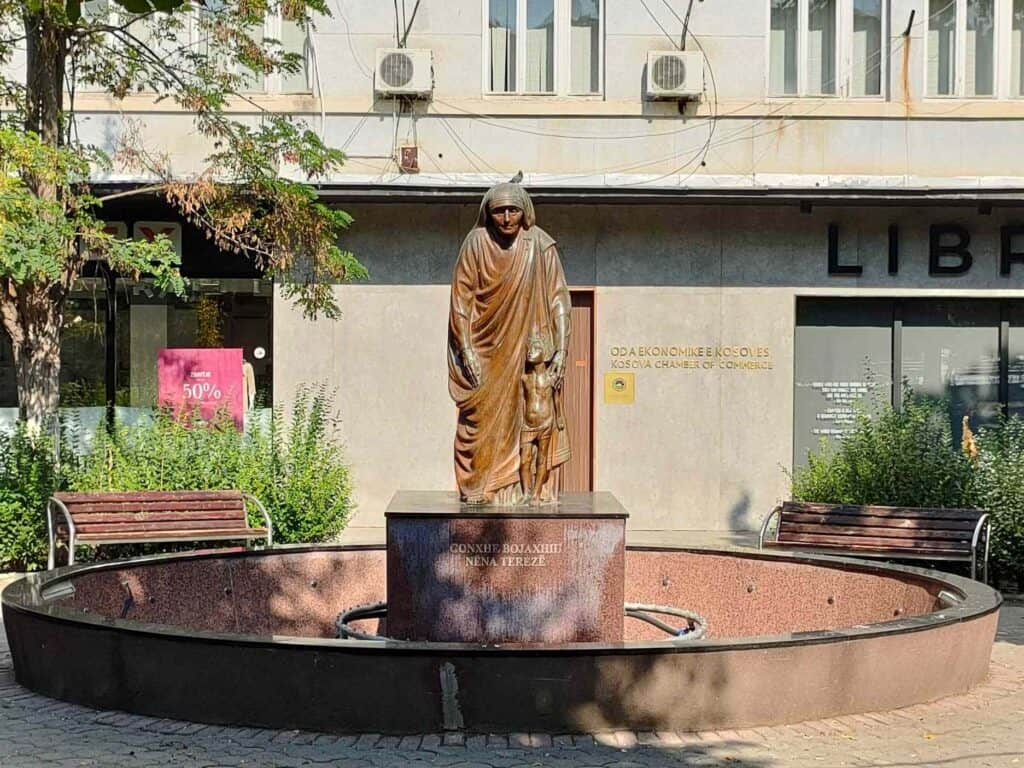
A far higher proportion of Albanians converted to Islam, perhaps because they did not have a national church like the Serbs, and Catholicism was not so deeply entrenched among them as it was among Croats.
Currency
It may come as a surprise, but the official currency of Kosovo is Euro. Montenegro and Kosovo are the two countries that are not members of the EU but have the Euro as the official currency. Plus, Bosnia and Hercegovina’s KM is pegged to the Euro. This makes it easy to understand the prices without any confusion.
Language
Albanian and Serbian are both official languages in Kosovo, even if Serbs are only 6-7% of the total population. All towns and villages have Albanian and Serbian names accordingly.
Thanks to the thousands of foreigners who lived here as part of the many international diplomatic missions, Kosovars have been exposed to different cultures. Also, as many Kosovars work abroad, mainly in Western European countries or overseas, you will probably meet someone who speaks English, German, or sometimes even French.
What are the best places to visit in Kosovo?
Pristina
Pristina is not an especially attractive city. It has messy architecture with high-rise communist designs, modern skyscrapers and some Ottoman heritage. Pristina doesn’t have stunning tourist attractions, but it has a vibrant nightlife coupled with super stylish restaurants and bars unparalleled in the summertime when seemingly all Kosovars who live abroad return to their homeland. The capital is definetely something you must include in your itinerary.
I wrote a separate guide about what you can visit in one day in Pristina and around, including the Gračanica Serbian Orthodox Monastery, that is part of UNESCO World Heritage and Gazimestan, Monuments to the Battle of Kosovo.
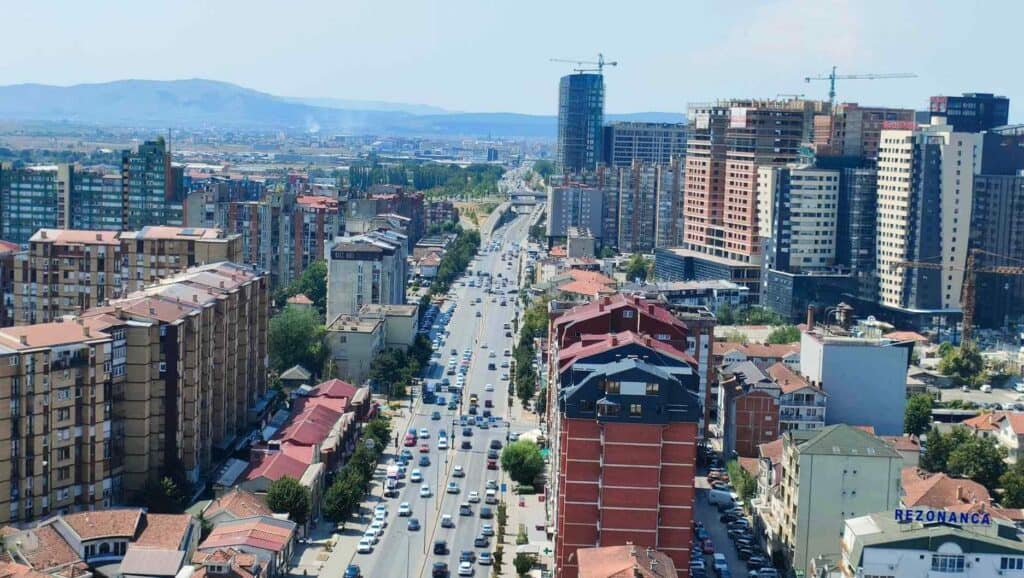
Prizren
Ask anybody, and they will say that Prizren is the best city in Kosovo. It has several historic monuments and lively nightlife with cafés and restaurants. This is the cultural capital of Kosovo, which you must include in your Kosovo itinerary. You can visit it on a day trip from Pristina or, better to say, overnight to immerse yourself in the bustling life of Prizren, especially during summertime when Kosovars return for their summer holidays. When you visit Prizren, you see that it is the most touristic city in Kosovo with quite a few attractions.
What you should know about Prizren?
What is special about Prizren is that this is the only municipality where, besides Albanian, Turkish and Bosnian are also widely spoken. Don’t be surprised to hear Turkish spoken in the streets. There are several inscriptions in Turkish, and restaurants offering Turkish food, as well as newspapers, radio broadcasts, and roadsigns. Prizren is the city with the most buildings preserved from the Ottoman period.
Prizren has always been the most culturally mixed city home to different communities (Muslims, Catholics, and Orthodox) and flourished as a trading town with more than 1000 shops. During the Ottoman period, it functioned as an administrative center. In addition, the League of Prizren, the Albanian political movement, was born here that wanted autonomy for Kosovo within the Ottoman Empire. Later, it became more radical and demanded independence, for which it even fought a war against the Ottoman Empire. A museum is dedicated to the movement.
Prizren reminded me of Mostar, although its stone bridge is less impressive than the one in Mostar. Apart from the well-known attractions, several small gems are scattered around the city, making you busy for a whole day.
Prizren gets busy during the prestigious documentary film festival every year in August. Finding accommodation, especially for a reasonable price, might not be easy. On the other hand, it is a unique experience to attend one of the biggest cultural events of the Balkan.
Book a tour to visit Gjakova and Prizren on a day trip from Pristina
The best things to do in Prizren
Walk up to the Prizren castle for a sunset view
It is a 15-minute steep walk up to the castle of Prizren, from where you get a fantastic view of the city and even Albania on one side. The castle occupies a larger area on top of the hill, but there is not much to see. It is a popular place for families to spend time where children can run around freely. A small kiosk sells drinks and ice in the fortress.
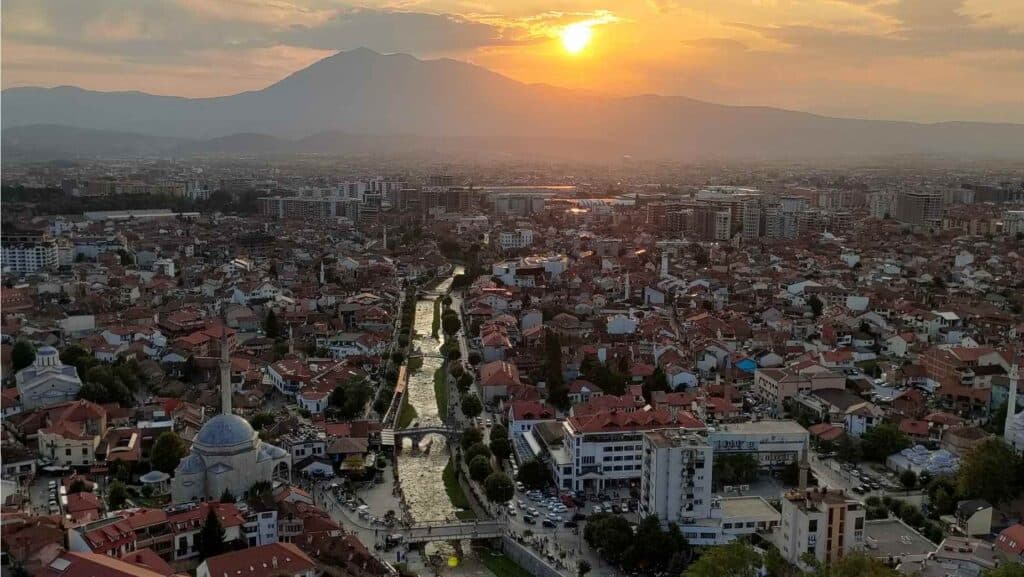
The best time to go there is at sunset. It is really impressive when the sun slowly disappears behind the mountains, illuminating the skyline dotted with minarets and church towers.
Our Lady of Ljeviš, UNESCO World Heritage
During my visit in the summer of 2023, the church was fenced off and not open for a visit. Still, it is worth having a look at this medieval monument listed as a UNESCO World Heritage that is in danger. It was built under the Serbian King Stefan Milutin in the 14th century at the site of a former Byzantine Church. Later, the Ottomans converted it into a mosque and added a minaret, but when the Serbians annexed Kosovo in 1912, it regained its original function. Like many other Serb Orthodox churches, it was also destroyed during the unrest of 2004.
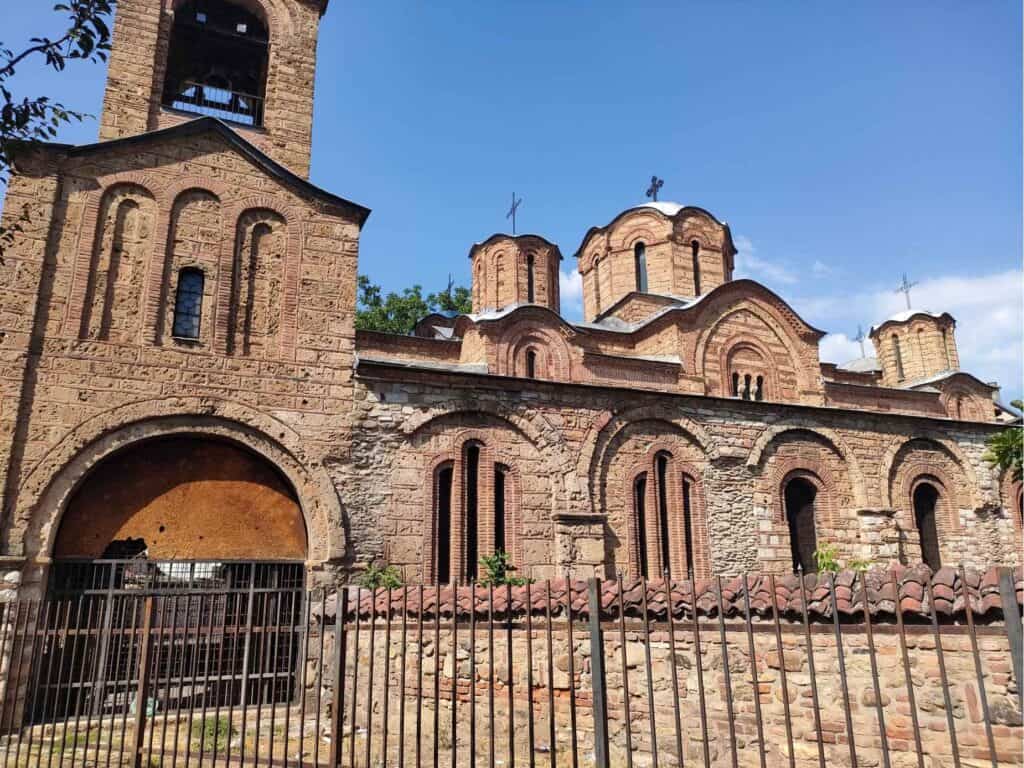
St. Saviour Orthodox Church in Prizren
On the way to the castle, you will pass by the orthodox church, built in the 14th century in Byzantine style. When I was there, the church was closed.
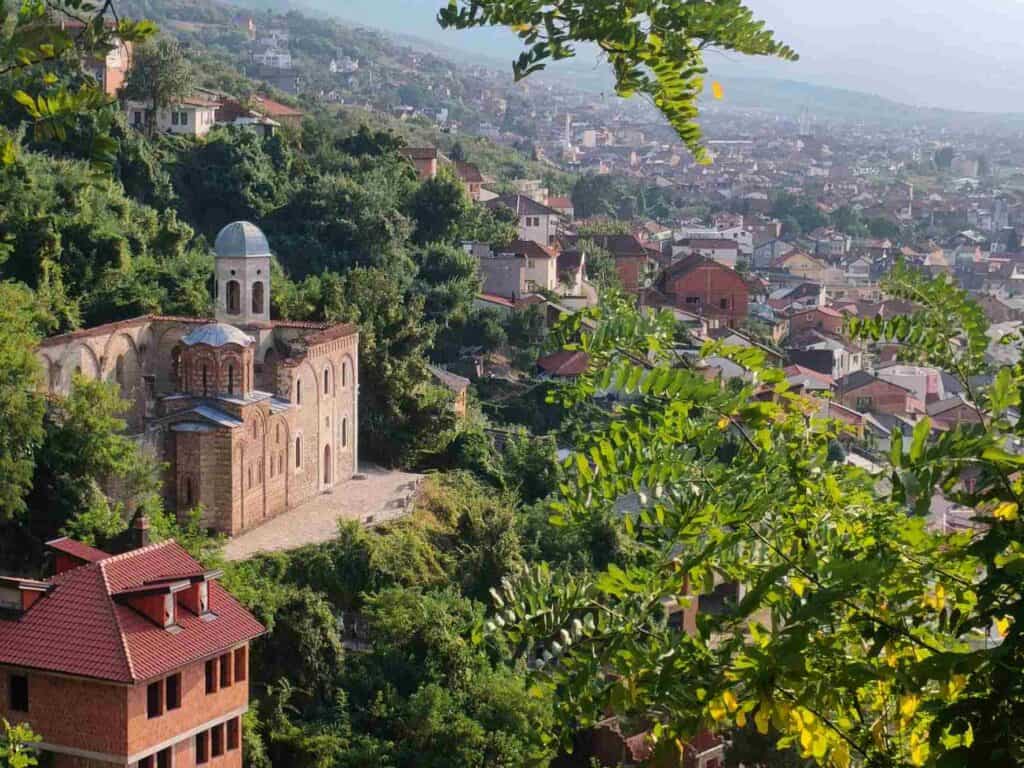
Cathedral of Our Lady of Perpetual Succour Roman Catholic Church
The Roman Catholic church, built in the 19th century, is worth a quick visit.
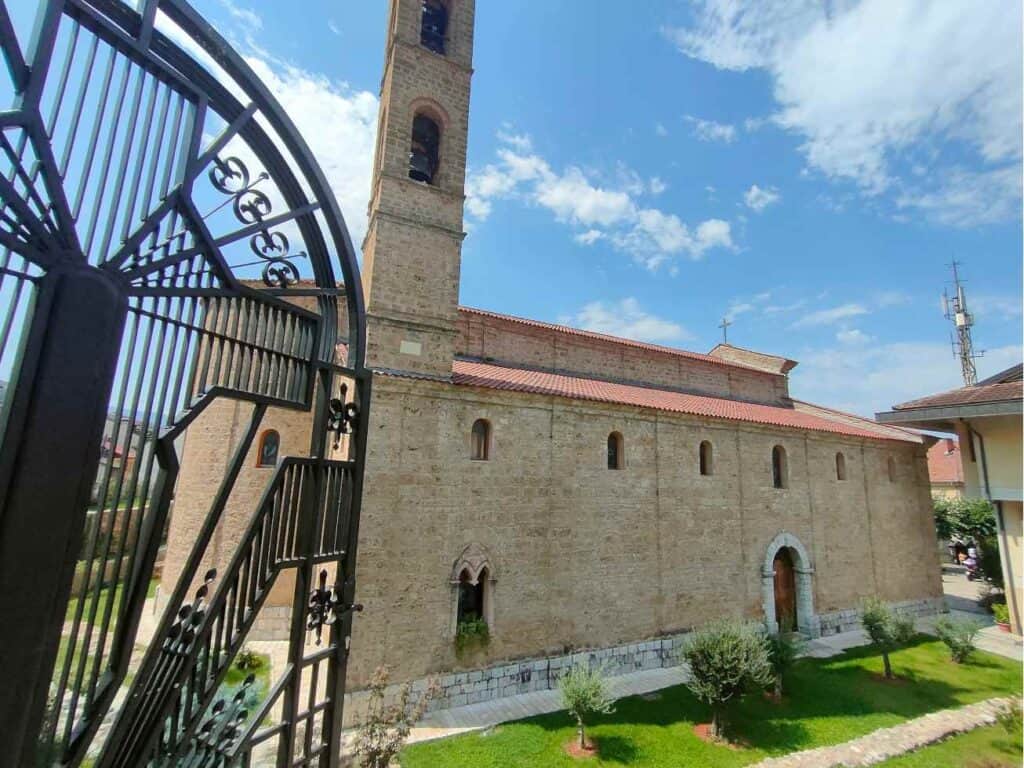
Taking the Sheshi i Shadërvanit street from the Catholic Church, you pass by the small Saint Nicholas Church dating back to the 14th century. Open the small iron door and go down the stairs to enter the church. Like many other Serbian Orthodox churches, it was also damaged during the unrest in 2004. Since 1990, it has been on Serbia’s list of Monuments of Culture of Exceptional Importance.
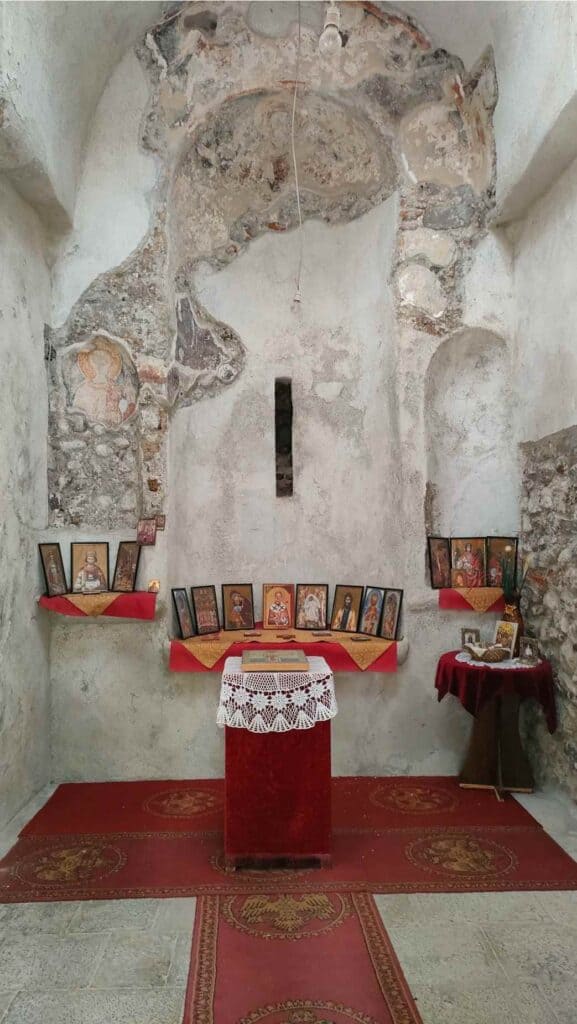
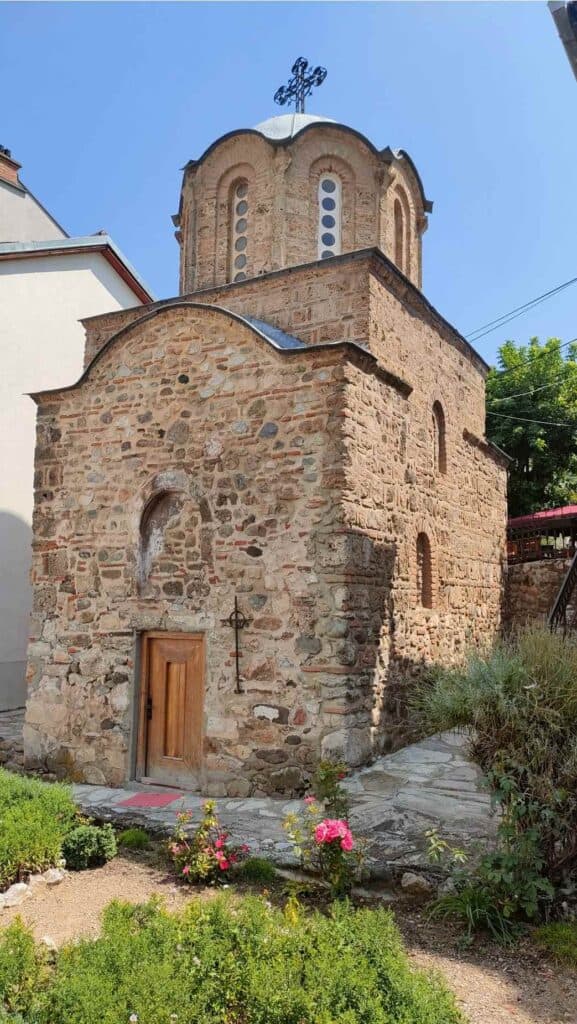
Beside the river near the stone bridge, you will find several restaurants with a perfect ambiance. Try some of the Kosovo specialties, drink a “raki” or a good Kosovar coffee that is the best outside Italy in Europe.
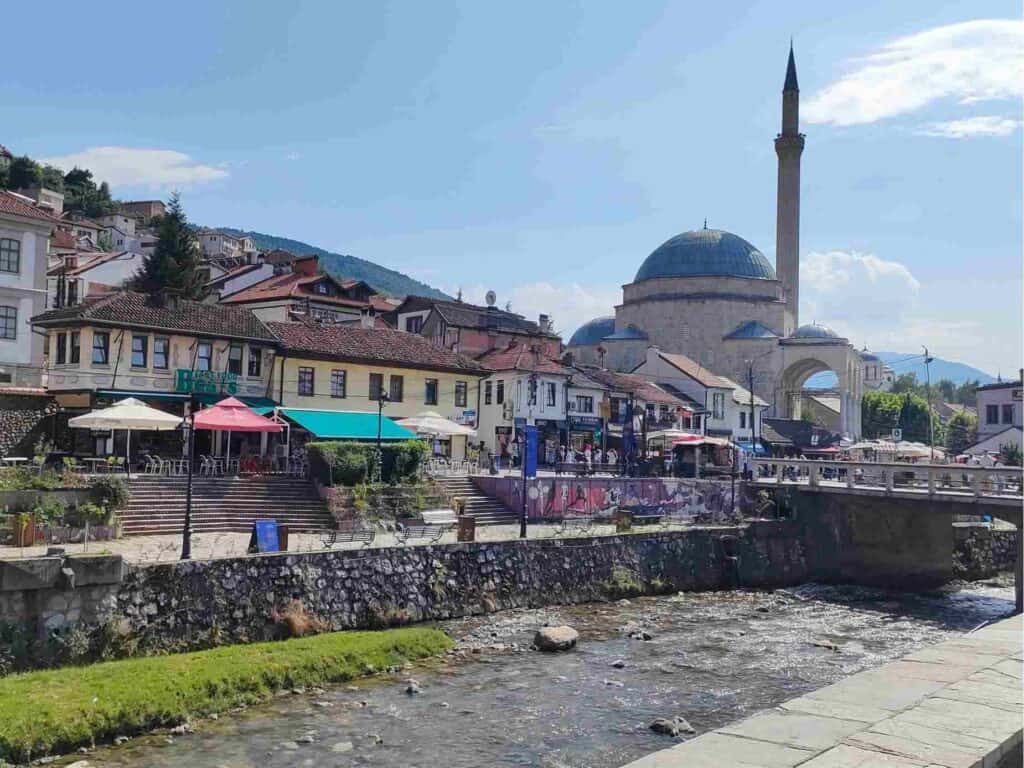
Opposite Hotel Theranda, the minaret of Arasta Mosque stands strangely alone, surrounded by modern buildings. When they converted the area into a shopping center, this part of the 16th-century mosque was preserved after local protests.
The more than 350-year-old Halveti tekke is currently under renovation. A tekke is where the members of the Sufi orders (a mystical branch of Islam) live and pray. There are 12 different sects; the most famous are the swirling dervish, who use this type of dancing to establish a closer connection with Allah.
The League of Prizren Museum is about the Albanian political movement that started in Prizren and wanted to gain autonomy within the Ottoman Empire but later demanded full independence. The Bajrakli mosque behind the League of Prizren museum dates to the 16th century.
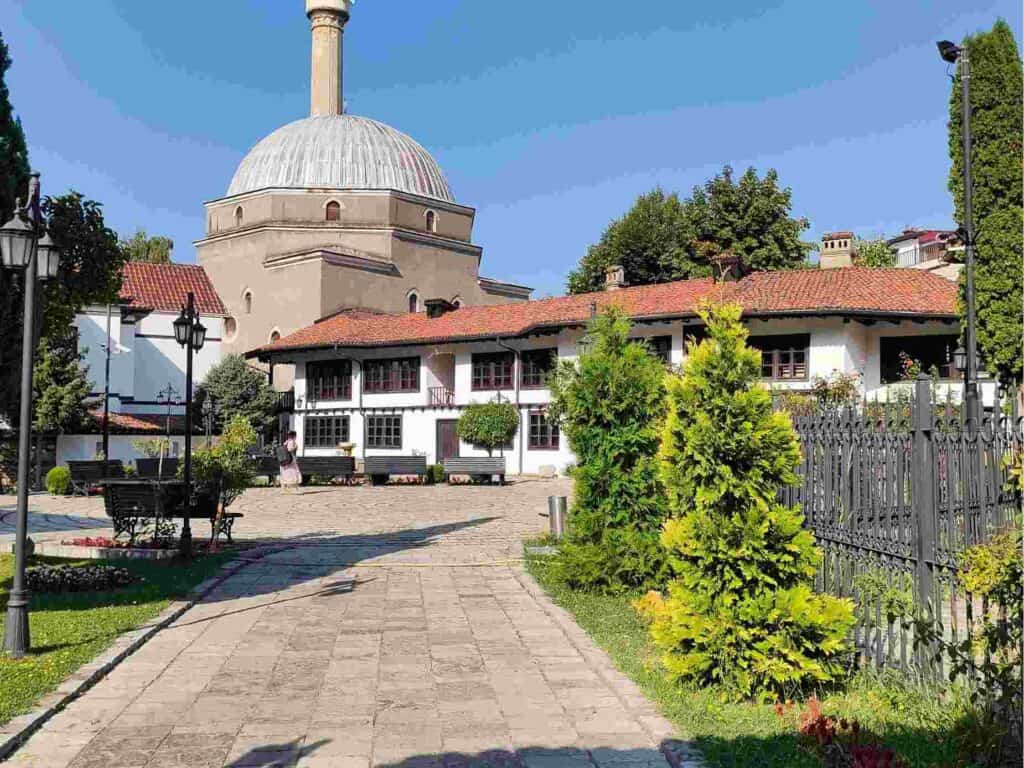
The Stone Bridge is a well-known symbol of Prizren. In 1979, the swirling storm waters destroyed the bridge, which was painstakingly renovated stone by stone in 1982.
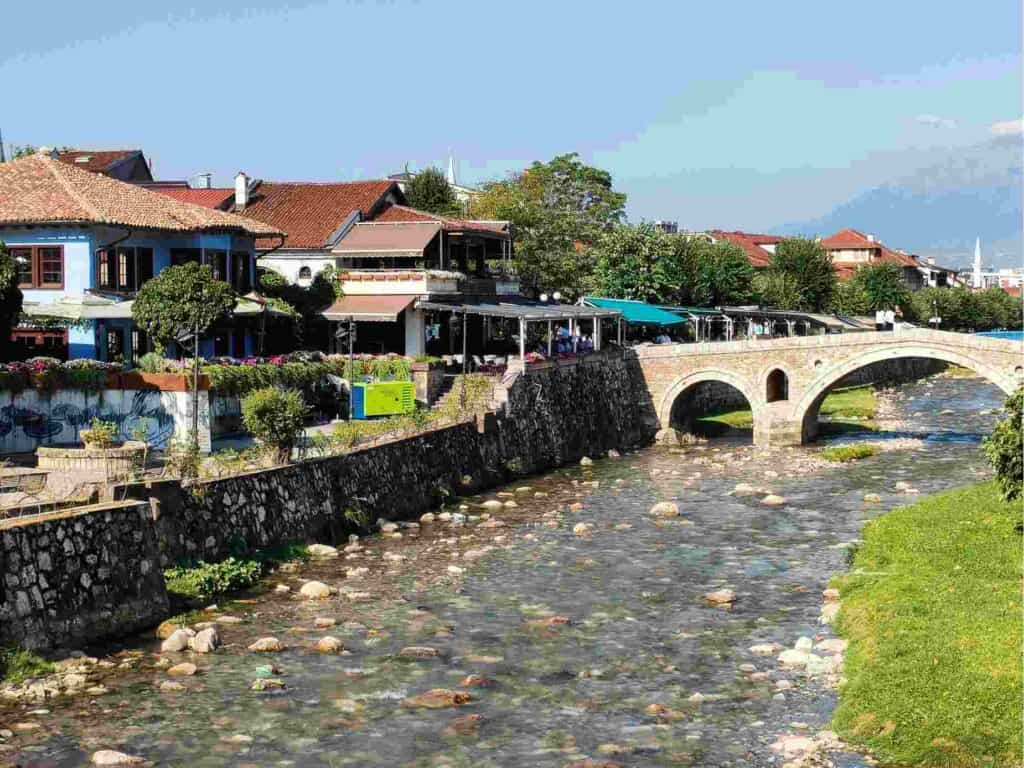
Sinan Pasha Mosque is regaded as Prizren’s main mosque
It is said that the stones of the Saint Archangels Monastery, which was in ruins by the 17th century, were used to build the mosque. While most mosques are only open for visitors during prayer time, this one you will probably be able to visit the whole day. The mosque’s interior has a colorful, stunning decoration of floral patterns and verses from the Qur’an. The minbar (the pulpit from where the imam delivers the sermon) also has a beautiful floral design.
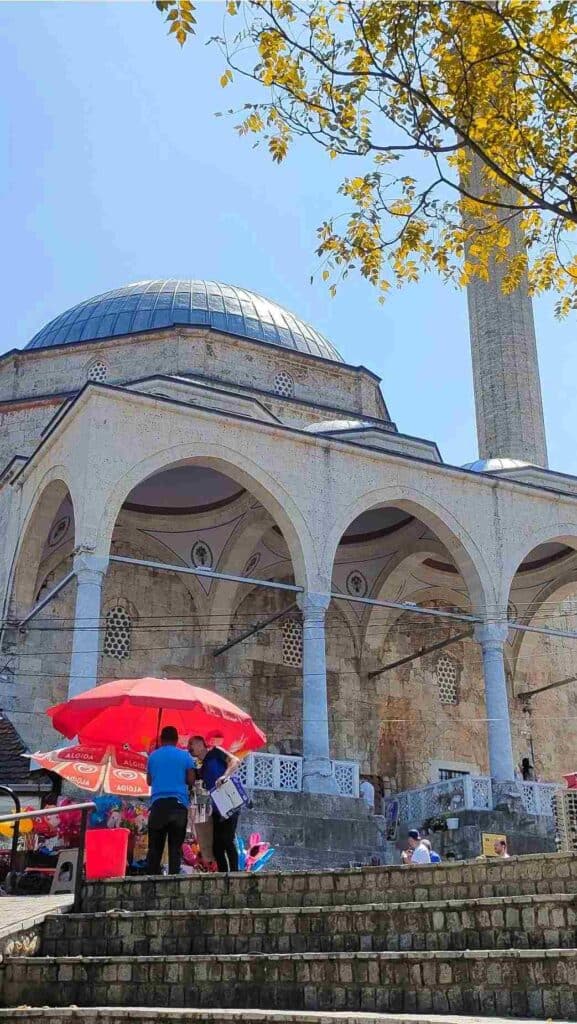
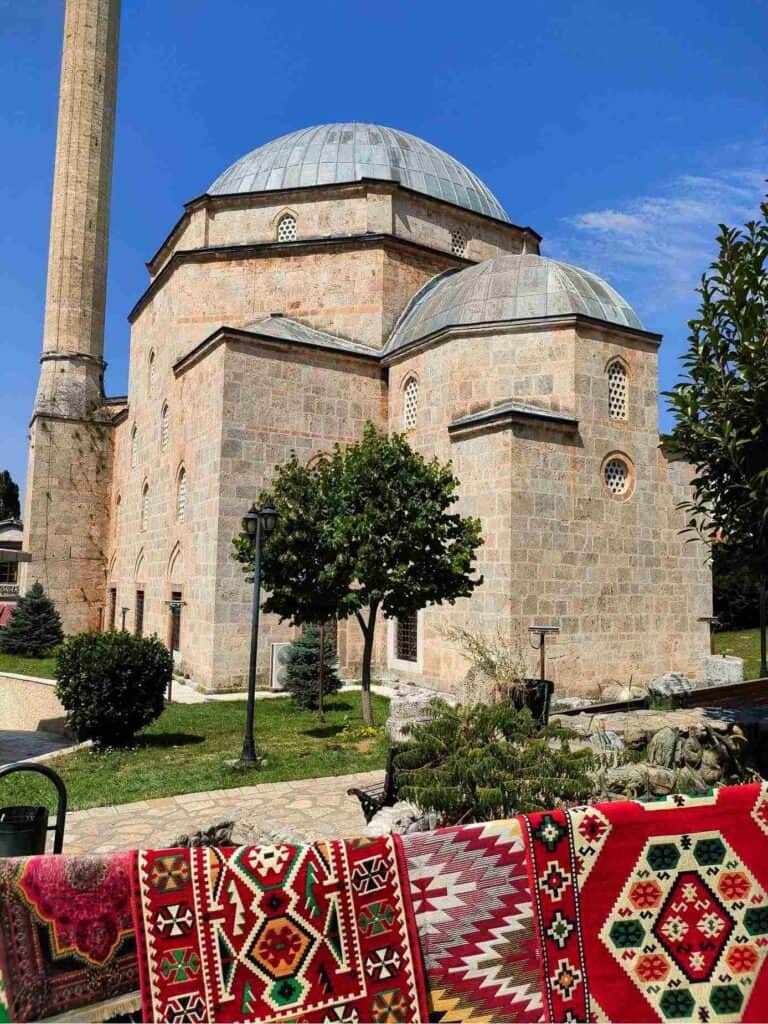
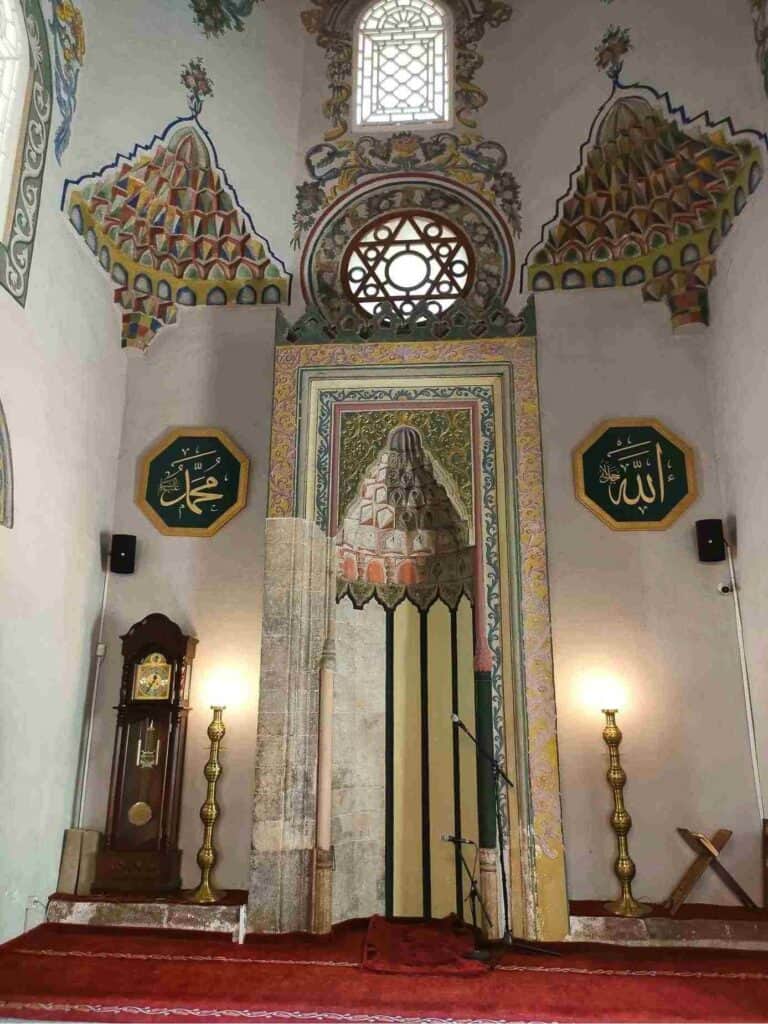
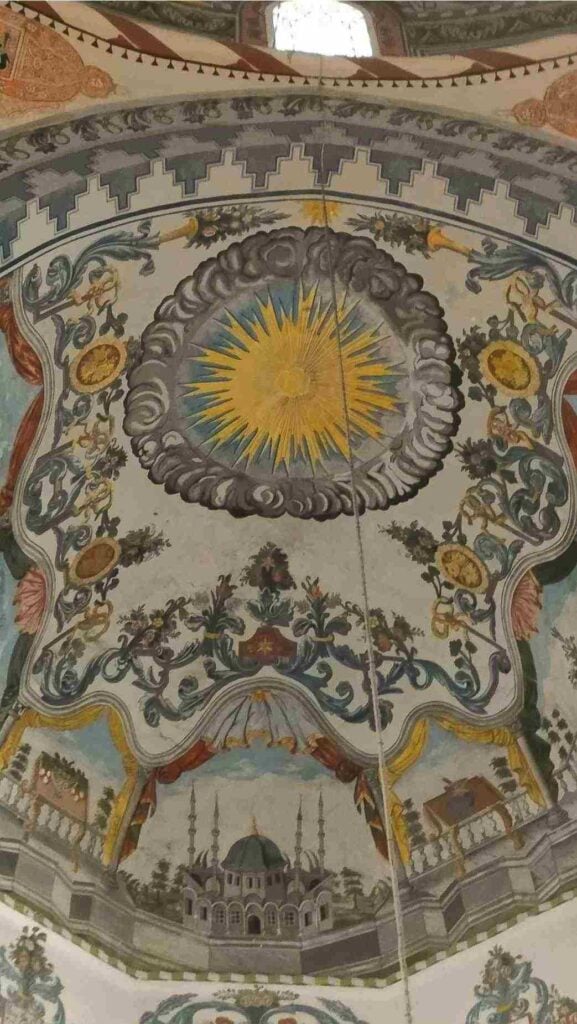
Monastery of the Holy Archangels
The Serbian Orthodox Monastery, located a few kilometers from Prizren in serene surroundings, was built by the famous ruler of the Nemanja dynasty, Stefan Dušan, and was planned as his burial place. The monastery included the monks’ dormitories, a library, a hospital, and two churches; in one was his grave.
After the conquest by the Ottoman Empire, the monastery was looted and severely damaged; as mentioned, its stones were probably used to build the Sinan Pasha mosque, but the remains of the old monastery are in the middle.
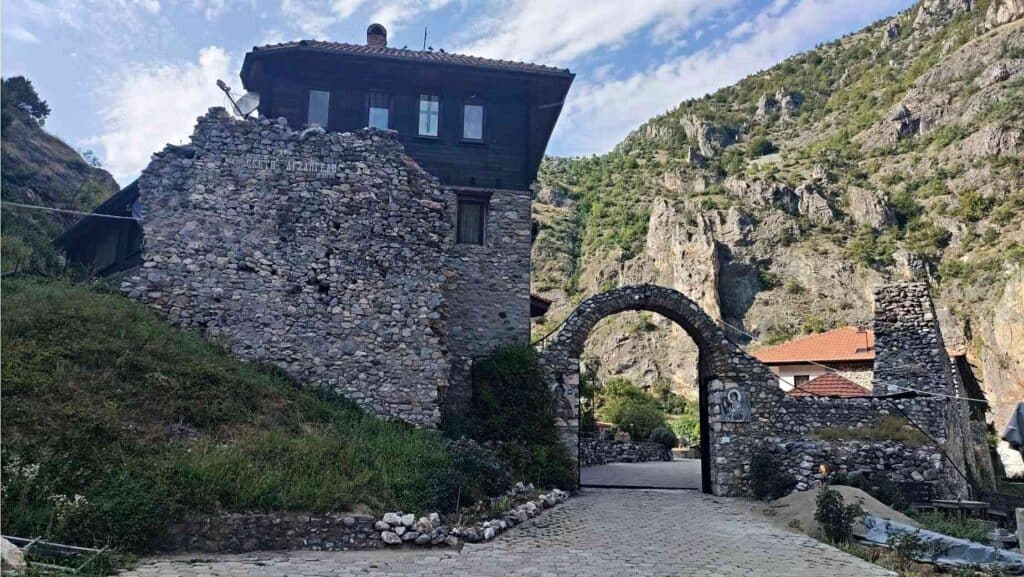
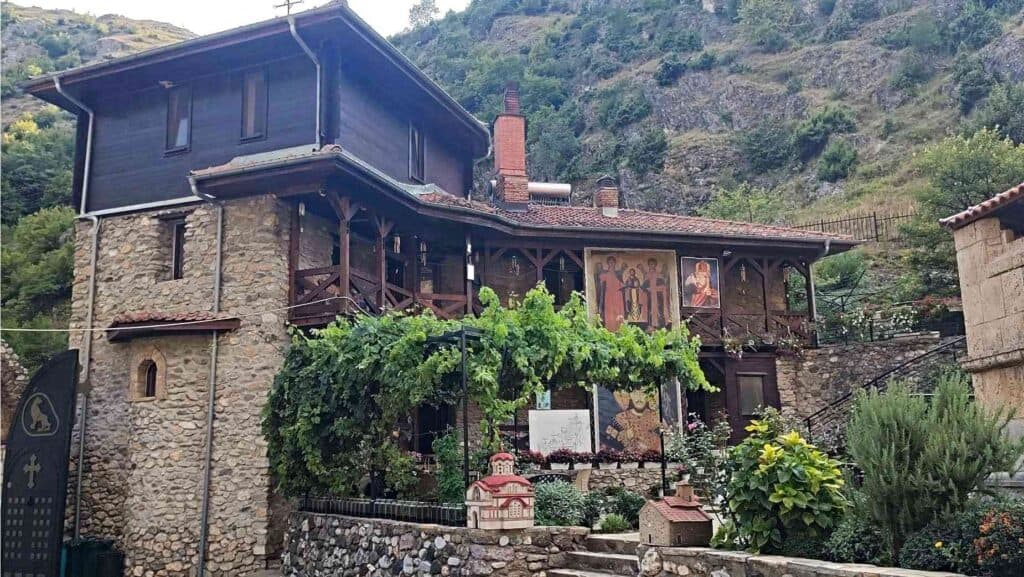
During the Kosovo War of 1998 and 1999, the Kosovo Liberation Army (KLA)- the Albanian separatist militia fighting for Kosovo’s independence- looted it when the Yugoslavian Army left after NATO’s bombing. During the Kosovo unrest in 2004, the most violent clashes between Serbs and Albanians since the war, the monastery was attacked and damaged. It is protected by the Republic of Serbia and classified as a Monument of Culture of Great Importance.
There is only one priest left in the monastery, whom you will probably meet during your visit, and he is happy to show you around and take a photo with you.
You can also stay overnight in the monastery’s guesthouse and enjoy the peaceful environment only a few kilometers from Prizren. There is a security check at the entrance, where you have to show your passport.
Where to stay in Prizren?
Low budget
Mid-range hotel
High-end hotel
Luxury Apartment near Old Town
Visoki Dečani Monastery
You should pass by Deçan city only to see the famous Serb Orthodox monastery, one of the most beautiful things to visit in Kosovo. It is set in a green, peaceful environment at the foot of the Accursed Mountains. The interior is covered by colorful frescos depicting Biblical scenes and the family tree of the Nemanjas, the biggest medieval Serb royal family. All in all, around 1000 figures appear on the frescos.
King Stefan Uroš III of the Nemanja family built this monastery in the 14th century and asked to be buried in the Dečani church. Like most Nemanja rulers, he was also venerated as a saint. His day is 24th November.
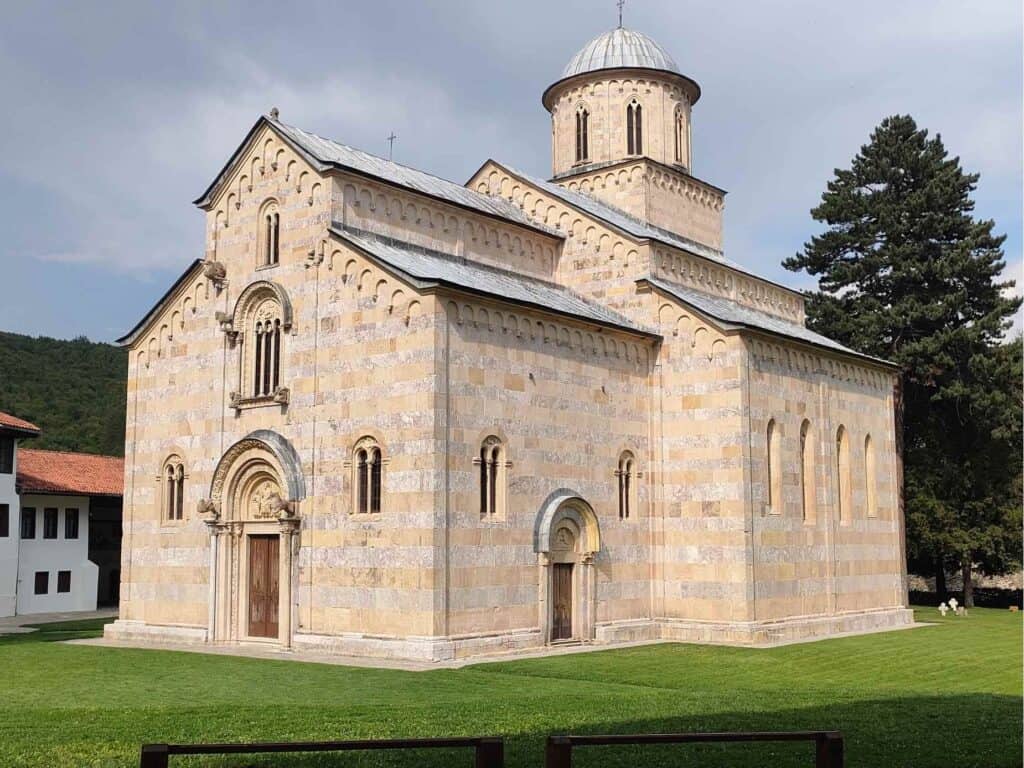
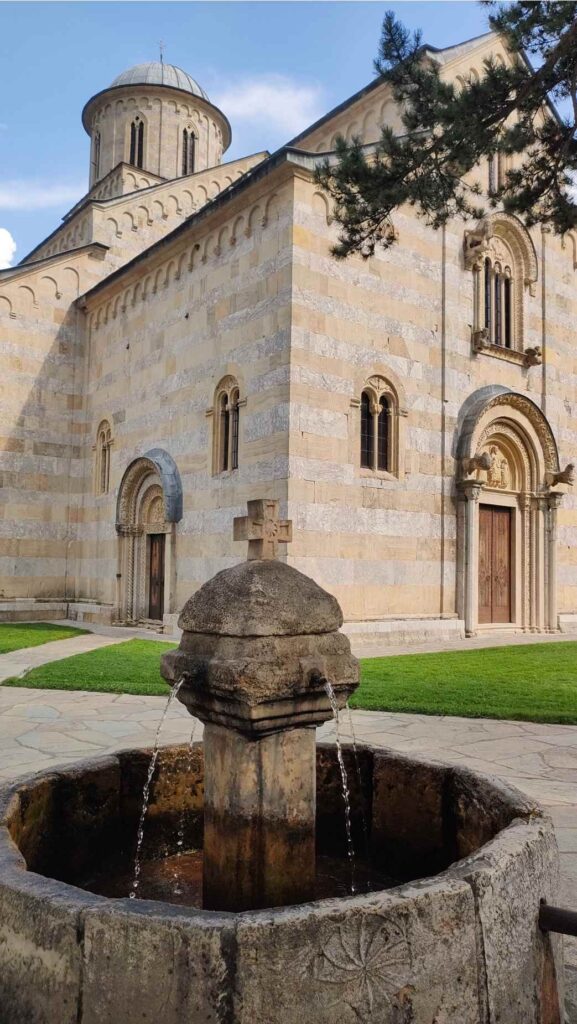
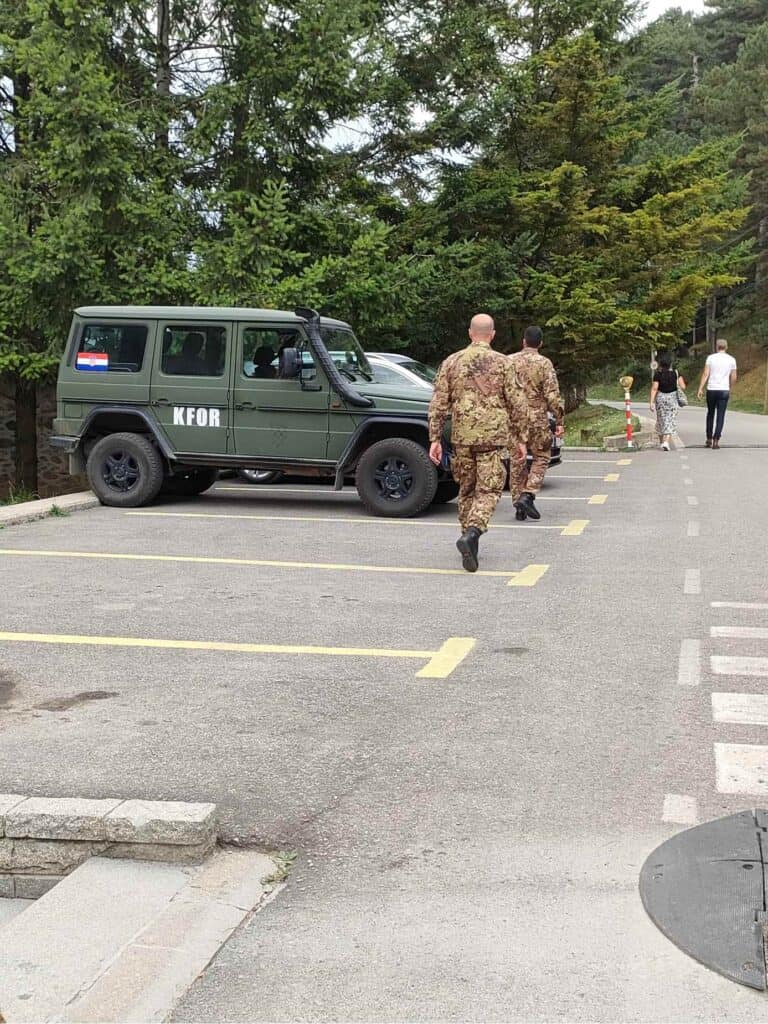
During Ottoman times, the monastery enjoyed special privileges, not only protection but also special tax status for the monks. According to the folk belief, the ruler’s tomb had healing power, so this place was venerated by Orthodox, Catholic, and Muslim Albanians alike.
The Visoki Dečani monastery is one of the four “Medieval Monuments in Kosovo” classified as World Heritage and the biggest medieval monument in the Balkan.
The founder, Stefan Dečanski (Stefan Uroš III), was buried in the monastery, though unfinished at that time, and his son, Stefan Dušan, finished the constructions.
The monastery sheltered refugees of all ethnicities during the Kosovo War in 1998 and 1999. During the Kosovo unrest in 2004, which started in Mitrovica and spread to the rest of the country, the NATO peacekeeping forces (KFOR) defended the monastery from an Albanian mob that attacked it like many other Serbian Orthodox Churches.
The monastery fell victim to a devastating fire in the 17th century, and only one monk was left.
Since the monastery lies in an Albanian-majority area, it is protected by the KFOR (Kosovo Force, a NATO-led international peacekeeping force in Kosovo). It means that you need to deposit your passport during the visit, the same as in the Patriarchate of Peć or Gazimestan memorial. The war ended in 1999, but tensions between Serbs and Albanians have been high. One of the latest incidents was when an Albanian visitor left a graffiti “UÇK” sign (Kosovo Liberation Army or UÇK was an Albanian separatist movement seeking Kosovo’s independence in the 1990s) on the frescos. Due to the prevailing tension, it is one of Europe’s most endangered cultural heritage sites.
Tip: On Thursday evenings at 7 am (outside the official visiting hours), visitors can attend the prayer and thus get a unique insight into the monastery’s life. Also, you can attend the choral church service at 8 am on Sunday.
Photography is strictly prohibited in the monastery, and a person in charge monitors visitors.
It is a nice gesture that all visitors are invited for a cup of tea or coffee, raki in the building opposite the church after the visit.
The monastery also has a souvenir shop.
Opening hours: every day, 9:30 am – 5:30 pm
Entrance fee: free of cost
How to get there?
Buses between Gjakova and Peja all pass by Deçan. From Gjakova, it takes 40 minutes, from Peja, it is half an hour’s drive. Get off the bus at the big roundabout from where the road continues to the monastery. It takes approximately half an hour to walk to the monastery. Half the way, there is a pedestrian way; for the rest, you must walk along the main road, but people often do that. Or you can take a taxi for 5 EUR.
Entrance fee: free of cost
Gjakova
Most people don’t include Gjakova in their Kosovo itineraries, but it was a pleasant surprise for me, and it makes an ideal stop between Peja and Prizren. Gjakova is part of Metohija, the large basin that covers the southwestern part of Kosovo. To the south, the Accursed mountains (as the Albanian Alps is called) rise. Gjakova’s main attraction is the 1 km-long Ottoman bazaar with around 500 shops of traditional artisans and modern boutiques and restaurants. Besides the shops, tekkes, mosques, and traditional kullas (fortified Albanian houses) are found in Gjakova. Although I didn’t stay in Gjakova overnight, the large number of restaurants and bars tells that the city has a vibrant nightlife. It also has some of the best restaurants in Kosovo. Gjakova is a religiously diverse city with 20% of the population being Catholic, and it has several tekkes. Gjakova is laos famous for its traditional music and nightlife.
Since most attractions are located in the Ottoman bazaar area, it is easy to get around on foot. Gjakova traditionally had a very low percentage of Serb population, for which it was seen as an Albanian stronghold.
In the 15th century, Gjakova was just a small village that turned into a bustling trade city by the 17th century and was considered one of the most developed trade centers in the Balkans.
Gjakova was a huge victim of the Kosovo War, as it was largely destroyed and suffered large-scale human rights abuses. The largest massacre of the Kosovo also took place near Gjakova. Several Serbian army and police officers were convicted for that. The majority of the population was expelled, who then returned after the war, but the city’s destruction was unparalleled.
The town was reconstructed, and you hardly see any signs of the destruction of 1999. In the aftermath of the war, Serbs fled Gjakova, and only a few stayed. During the 2004 Kosovo unrest, the Serbian orthodox church was destroyed, and the last few Serbs were expelled.
How to get there?
There are regular buses from Prizren, Peja/Dečan Pristina to Gjakova (every 15-30 minutes) that cost 2-4 EUR. It is only a 10–15-minute walk from the bus station to the city center.
Prizren-Gjakova: 3 EUR
Gjaova- Dečan: 2 EUR
Dečan- Peja: 2 EUR
Old or Grand Bazaar (Çarshia e Madhe)
The Old or Grand Bazaar (Çarshia e Madhe), built around the principal Hadum mosque, is the most attractive part of the city, with several shops and residential buildings. This is the oldest bazaar in Kosovo, and the 1-km-long wooden market recalls the time when Gjakova was the principal trading center during the Ottoman period for hundreds of years.
The entire market was set on fire in 1999, and as it was constructed of wood, the fire caught on quickly. It is incredible how they managed to restore the market in its original form.
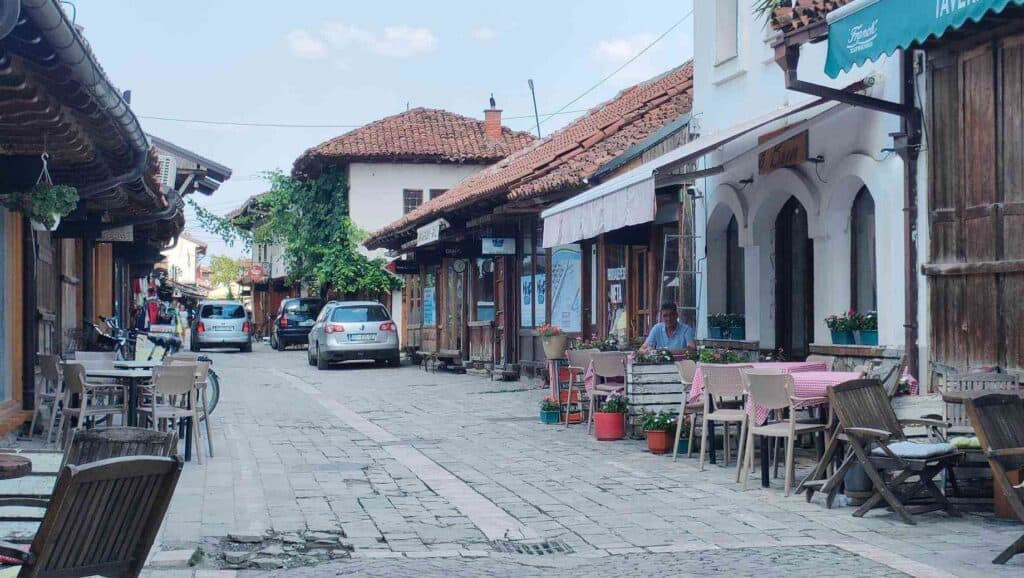
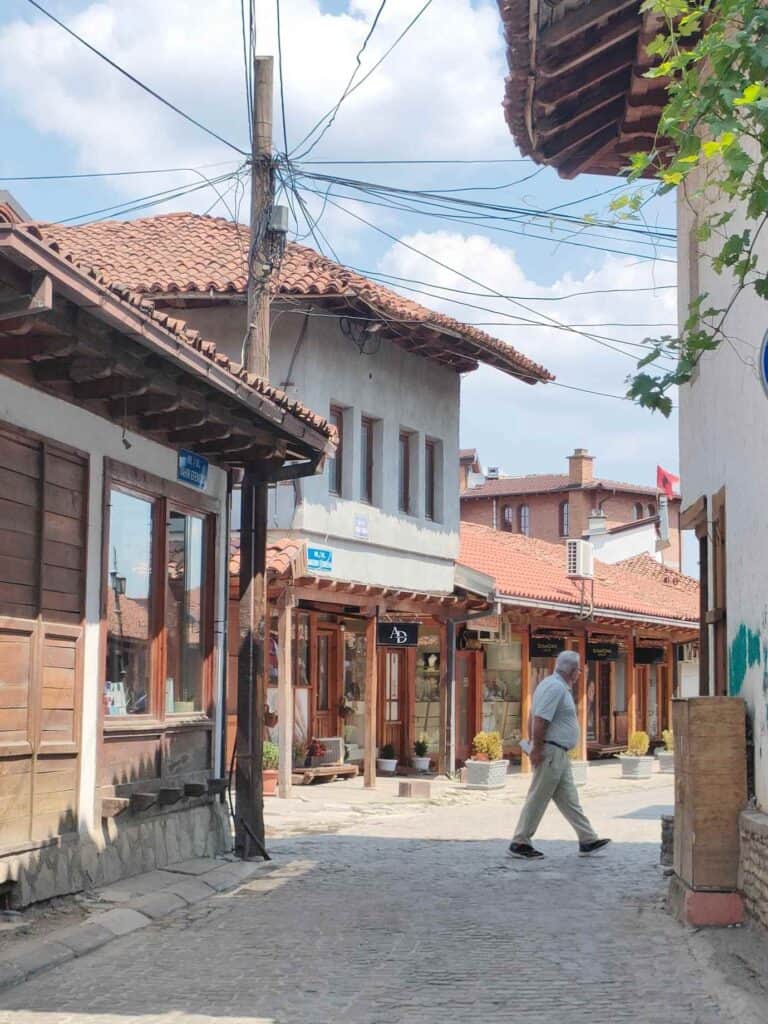
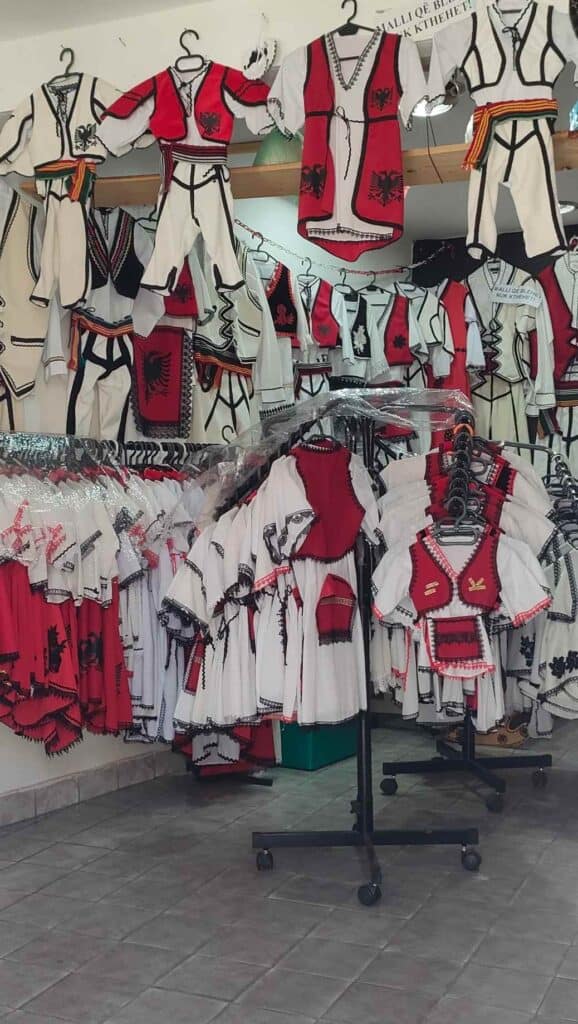
Hadum mosque
The principal mosque of Gjakova was donated by Hadum Sylejman Efendia (Hadum Aga) at the end of the 16th century, hence the name. Its interior floral (including cypress trees) and geometrical decoration mixed with verses from the Quran make it one of the most impressive mosques in Kosovo. The colors of the interior painting are not harsh—the contrary. The combination of light colors creates a perfect harmony.
As in every mosque, there is a mihrab indicating the direction of Mecca and a minbar used by the imam for preaching.
At the side of the mosque is a small graveyard with the tombs of notable people of Gjakova. It was a bigger complex, but in 1999, the hammam, a library (with hundreds of years old manuscripts that told the history of the minaret), and religious schools were destroyed. Even the minaret was shot off. They restored the mosque, the minaret and the library.
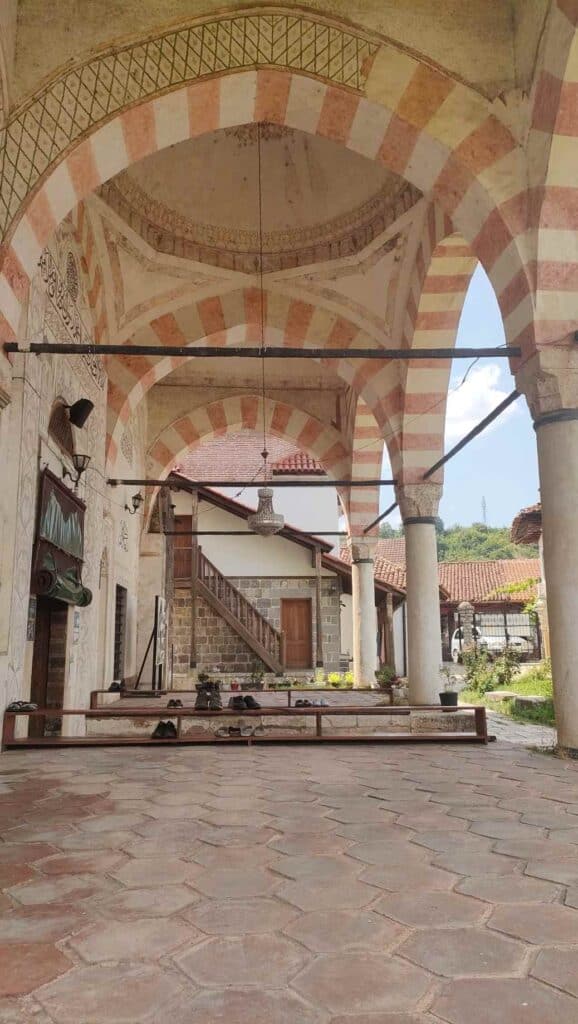
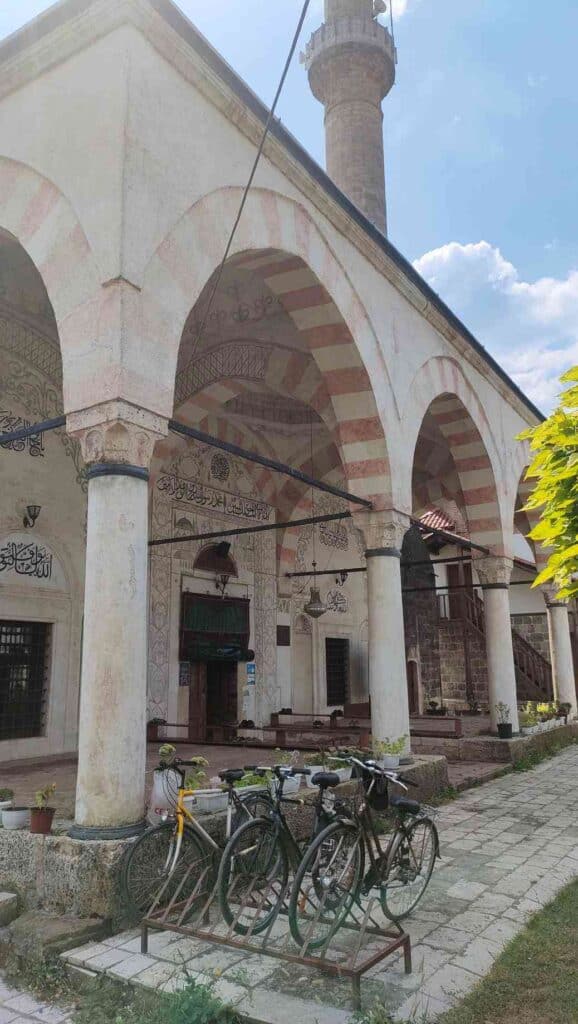
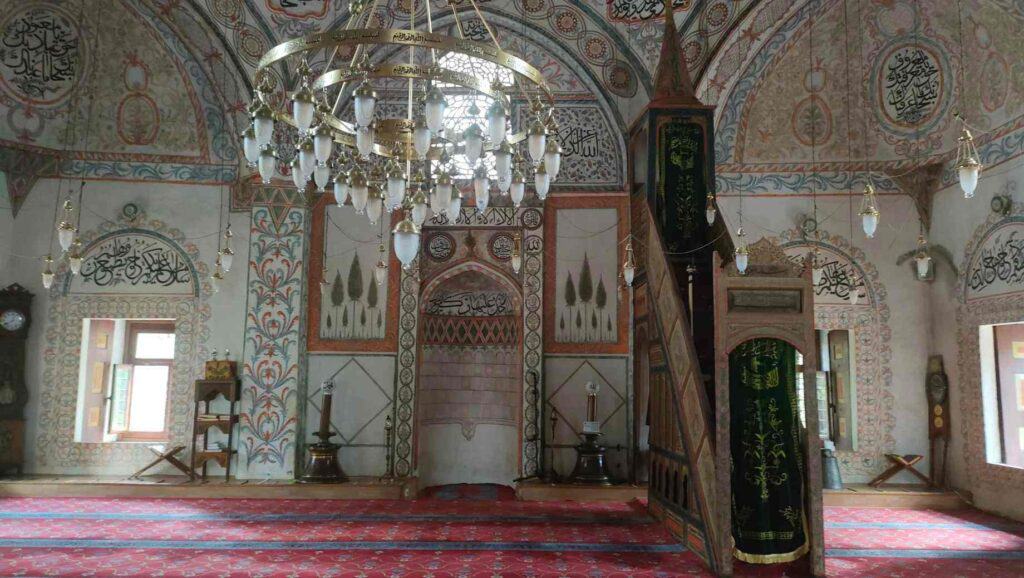
After the construction of the mosque, the craft shops were built around it as part of the Old Bazaar with a clock tower (Sahat Kulla) to determine the city’s working hours.
Visit some local craftsmen who still pursue traditional trades. Gjakova is famous in Kosovo for its hand-made wooden cradles (“Diep”) with unique carvings and colorful paintings that you can see in some of the shops. Other artisans make the “Plis”, the traditional white Albanian hat, and Gjakova is also famous for its Albanian seamstresses.
As mentioned, there are a couple of tekkes (Sufi places of worship), including the Great Tekke (“Teqja e Madhe”) that belong to the Saadi order. Tekkes usually include a prayer hall, mausoleums of venerated members of the order, residential buildings and fountains.
Since Gjakova has a significant percentage of the Catholic population (20%), there are two main Catholic churches in the city as well: Saint Paul and Saint Peter Church, whose towers are seen almost everywhere in the city, and the Saint Ndou Church.
Kulla of Abdullah Dreni Pasha
Kulla is a fortified tower built in a square shape with thick stone walls, usually 2-3 stories high, connected by a small staircase. The families’ living quarters occupy the second floor while the ground floor, lacking windows, has defense purposes, and this is where animals are kept. The third floor was where men welcomed guests. At times of insecurity in the 18th and 19th almost every family had a kulla built of massive stone. Later, at more peaceful times, they used wood, and the family slept in a building next to the kulla. Kullas are considered as Albanian heritage.
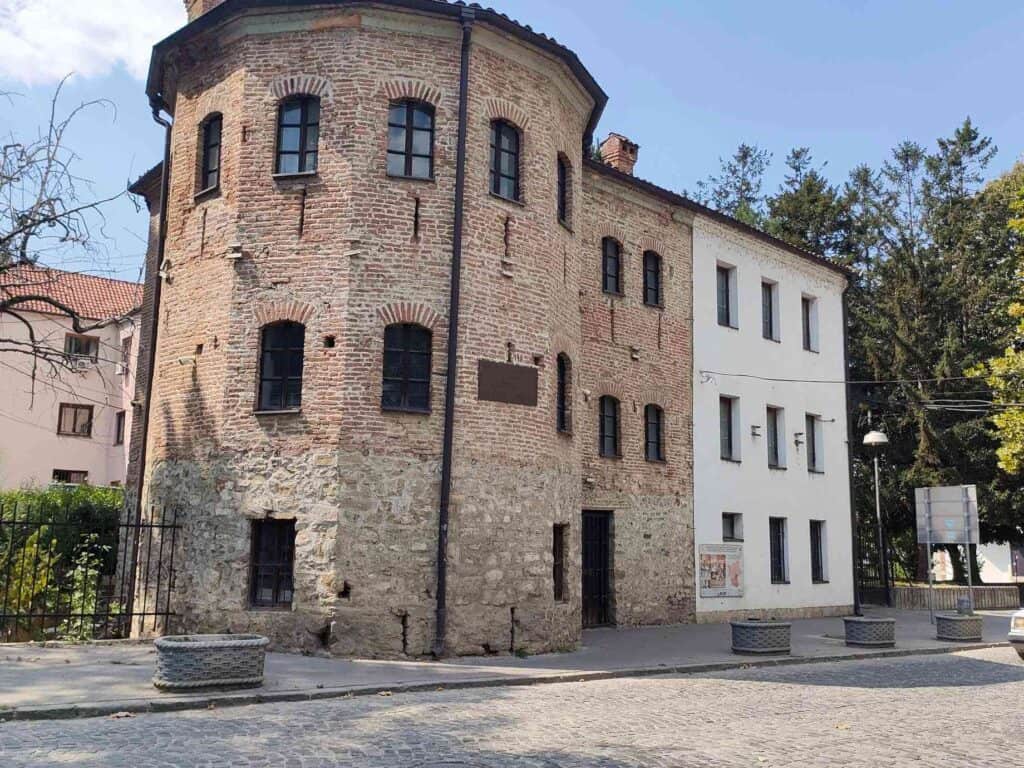
In the early 20th century, kullas were increasingly built of brick. The instability and insecurity of the late 18th and early 19th centuries in western Kosovo led to a real boom in the construction of kullas. In some villages like Junik or Drenoc near Deçan, every family would have a kulla surrounded by high stone walls. As unique symbols of Albanian architectural heritage, kullas were targeted during the 1999 war.
You can visit two other things in Gjakova.
The Ethnographic Museum, built in the 19th century, though you can also find one in Peja.
The Kompleksi Memorial “27 Prilli” contains graves of the war of the 1999 conflict with photos of the victims. Gjakova was probably the most destroyed city during the war; hundreds of people are still missing. Take a car to get to the memorial up on the hill.
Where to eat in Gjakova?
Restaurant Kulla Gjakova
Restaurant Illyricum Qabrat: with a nice view of the city
Gastroteka Republika
Where to stay in Gjakova?
Hotel Çarshia e Jupave (traditional Albanian kulla converted into a hotel)
PEJA/PEĆ
Peja, the third biggest city of Kosovo after Pristina and Prizren, is a place you must include in your Kosovo itinerary, even if you only have a few days. If you have two days, spend one day discovering the Rugova Valley, hiking, or just stopping at viewpoints and enjoying the fantastic nature.
On the other hand, Peja was an important trading town during the Ottoman times and the center of the Albanian movement. The League of Peja was founded based on its forerunner, the League of Prizren to protect the Albanian interests within the Ottoman Empire. A square, a tower, a mill, and even the public university of Peja were named after Haxhi Zeka, the movement’s leader. And, of course, his statue is also found in the city.
In the communist era, Peja was industrialized, and several factories were opened, including a sugar factory and a brewery. Peja produces Kosovo’s most popular beer.
Like most of Kosovo’s cities, the famous bazaar of Peja was heavily destroyed during the war of 1999 but restored as much as possible in its original Ottoman style.
Similar to Pristina, some streets are also named after prominent persons who played an important role in the NATO intervention against the Serbs during the Kosovo War. One bears the name of Tony Blair, who actively pushed NATO allies to intervene. Another one after Madeleine Albright, the former US Secretary of State, and there is simply a NATO street.
What to see in Peja
Peja has two main parts: the old bazaar and the modern city center. They are approximately 10 minutes walk from each other.
The old bazaar
The old bazaar, initially built in the 15th century, was almost entirely destroyed during the Kosovo War of 1998-1999 but was restored as much as possible with the financial support of the European Union. Çarshia e Gjatë is the main street of the old bazaar and the most attractive at the same time, nicely illuminated at night. Unfortunately, shops are closed by sunset, and despite the beautiful lights, only a few people stroll around as life switches to the modern city center.
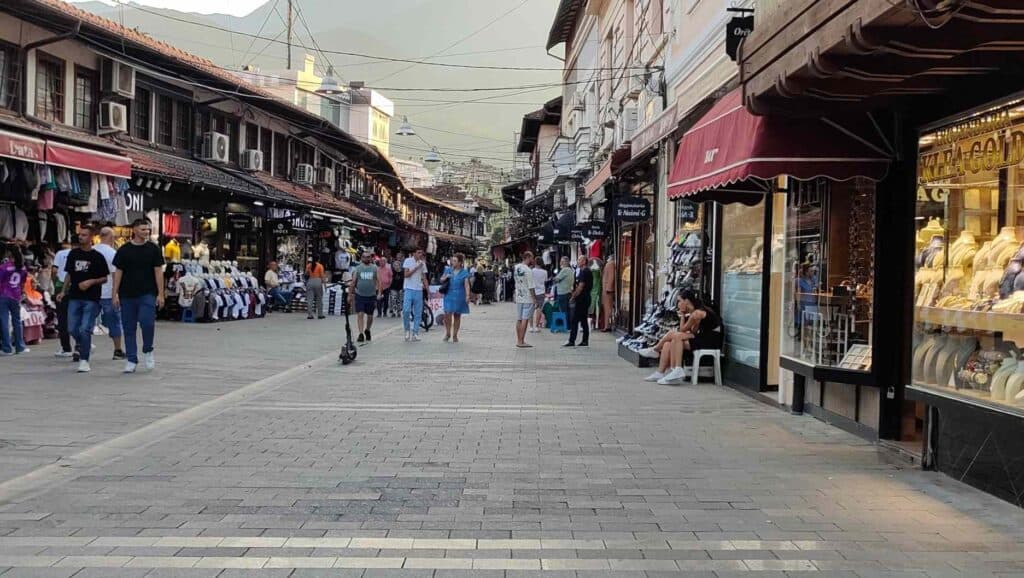
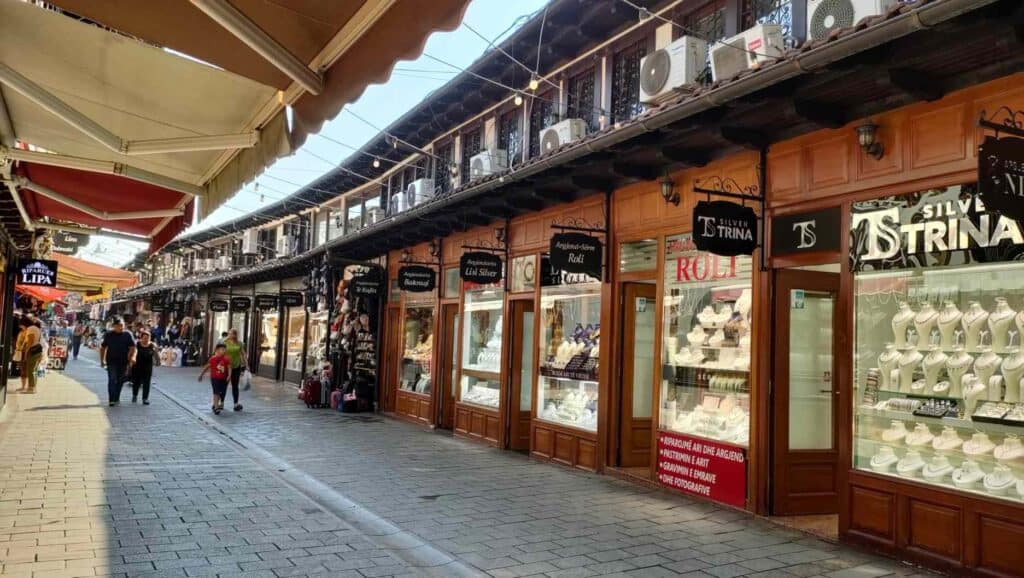
The old bazaar is dotted with Ottoman-style residential buildings and craftsman shops, with man)y selling gold jewelry, a traditional gift (dowry) to the bride, during the wedding. In its golden era, almost 1000 craft shops of different trades existed. Only a few traditional crafts (Blacksmithing, tailoring, tanning, hat making, pottery, weaving) are still practiced.
In the center of the old town stands the Bajrakli Mosque, also known as the Çarshia or Market mosque. Try to get in before or after prayer times. The small cemetery next to the mosque has some unique tombs in the shape of traditional headgear, including turbans or religious hats worn by those who completed the Hajj, the traditional pilgrimage to Mecca.
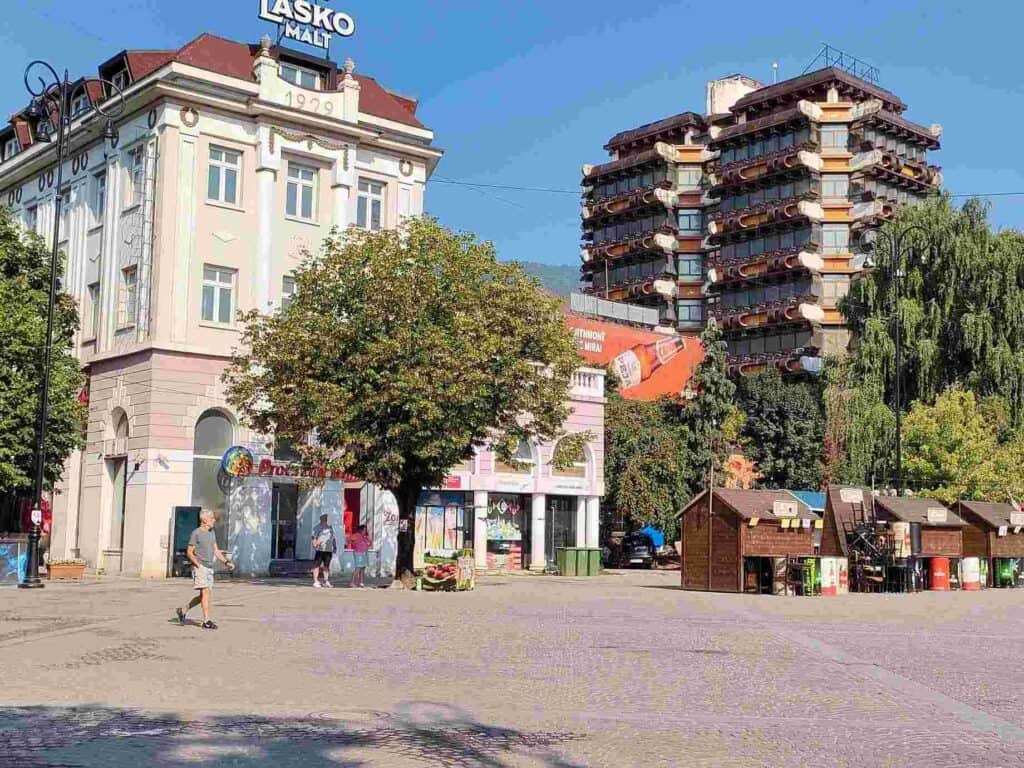
Visit some nice examples of Kullas
The traditional fortified towers were residential homes used during times of insecurity. Peja has quite a few of them. You can even spend the night at a kulla converted into a hotel (Hotel Kulla e Zenel Beut) as a unique experience. The hotel also has a nice restaurant with an outside terrace. This is one of the best restaurants in the city.
The Haxhi Zeka kulla still belongs to the family of the renowned national activist, and is not open to the public, but you can still have a look from the outside.
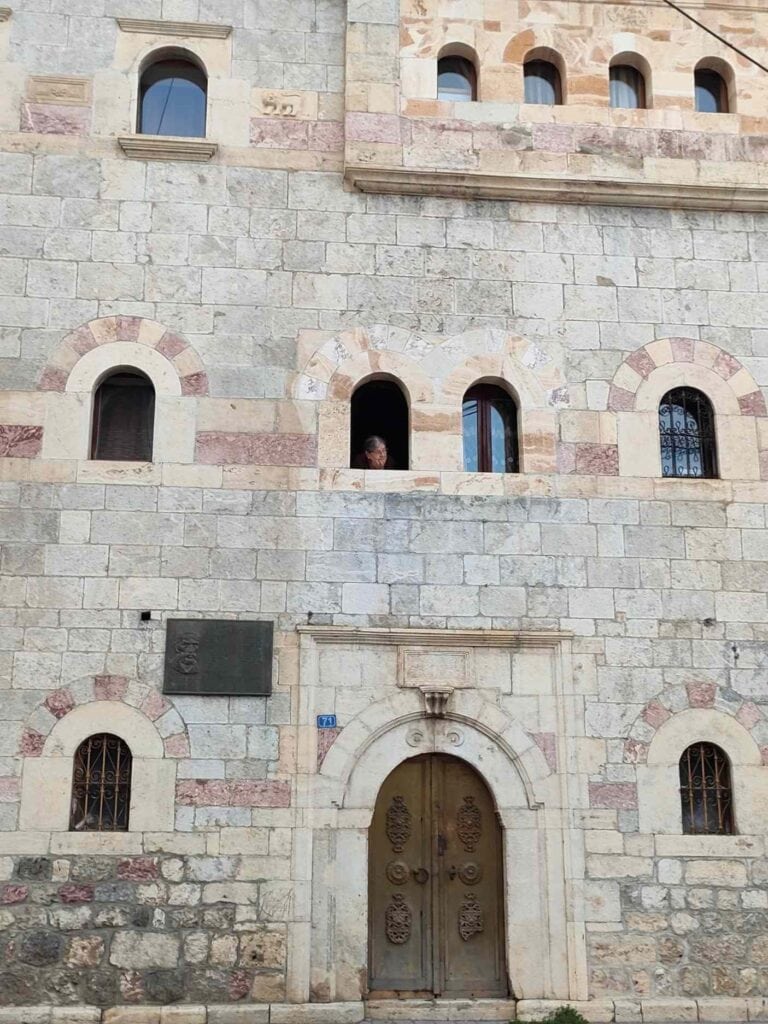
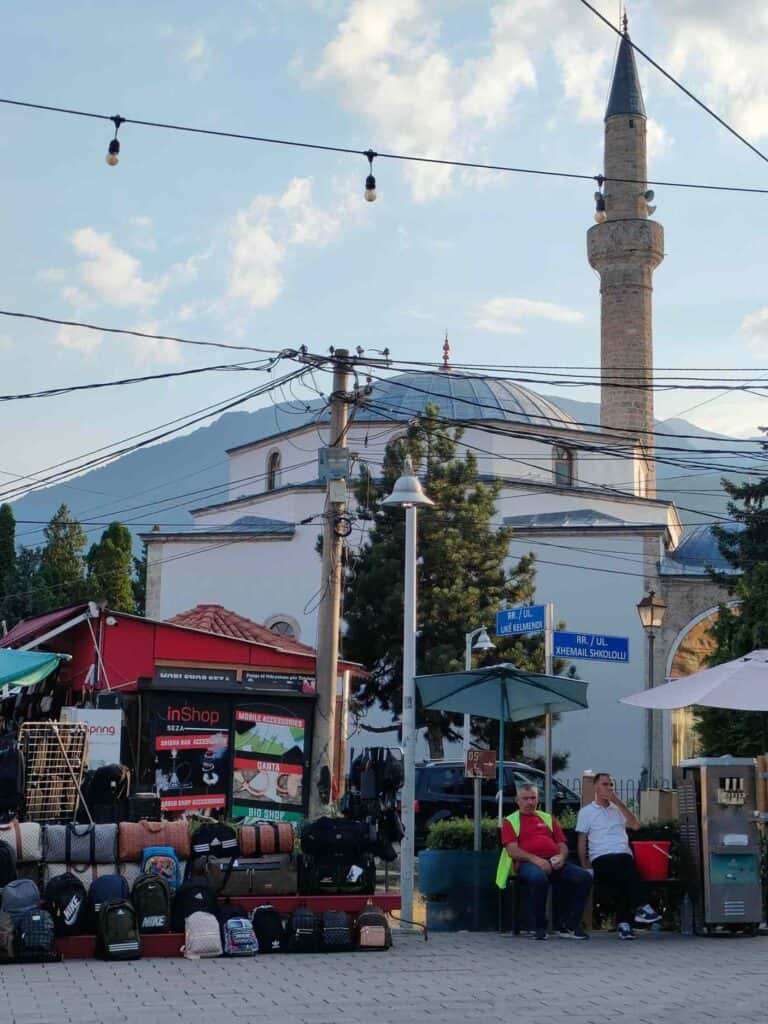
The Peć Patriarchate
Being the seat of the Serb Orthodox Patriarchate, Peja is the spiritual center of the Serb nation, where several archbishops and patriarchs are buried. With Gračanica, Viskoki Dečani Monastery, and the Serbian Church of Our Lady of Ljeviš, it is classified as a UNESCO World Heritage under Medieval Monuments in Kosovo.
The monastery is at the entrance to the Rugova Canyon, surrounded by the Accursed mountains and lush vegetation.
Like Gazemistan or Visoki Dečani Monastery, being a sacred Serbian place in a region mainly inhabited by Albanians, it is protected by KFOR. You need to deposit your passport during the time of the visit.
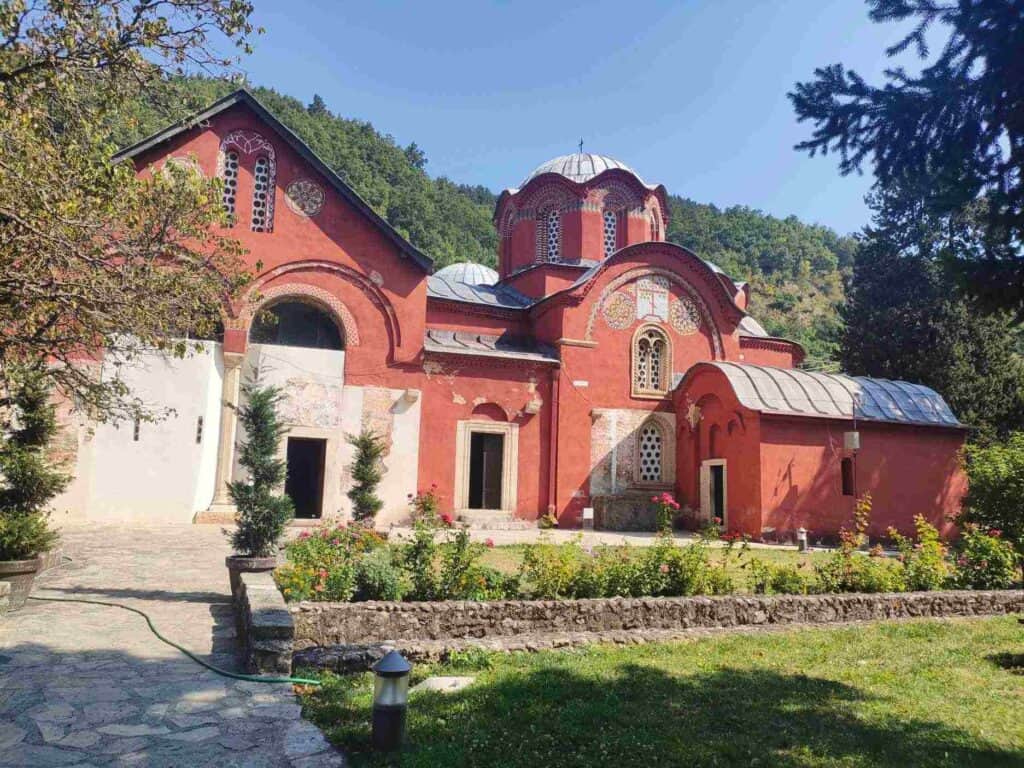
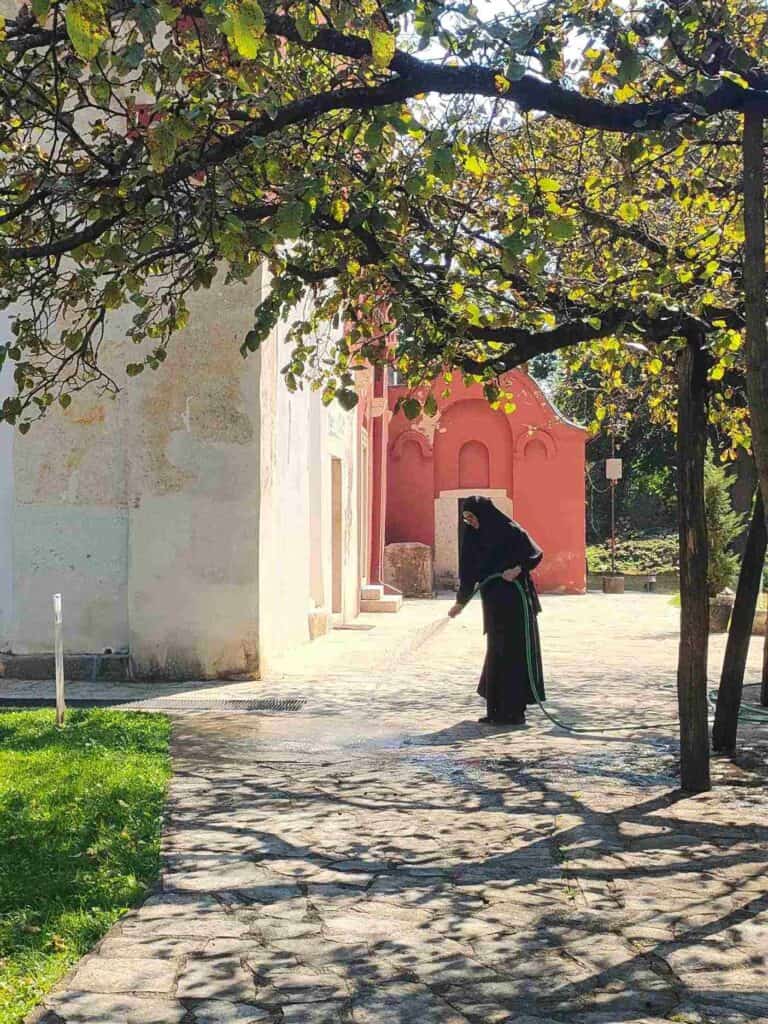
Peja became the seat of the Serb archbishop and later patriarchs after the original seat at Ziča Monastery in Serbia fell victim to a Bulgarian attack. Serbian Emperor Stefan Dušan moved it to Peja, which seemed to be a safer place on a plain protected by the Rugova gorge in 1346. It remained the seat of the Serbian Orthodox Church until the Patriarchates were abolished in 1766.
How to get there?
The monastery is a short 20-25-minute walk from the center of Peja. On the way there, pass by the Tourist information for Rugova, where the staff is very helpful and gives suggestions about shorter and longer hikes in the region.
Take a photo of Hotel Dukagjini
The most famous luxury hotel in Peja is worth looking at, even if you don’t stay for the night. It has an interesting history. Under Milošević, Serb paramilitaries converted it into a casino, and then for several years after the war, it housed a contingent of Italian carabinieri stationed in the Peja region. In 2005, it was privatized, and now it is a high-end hotel but much more affordable than something similar in Western Europe.
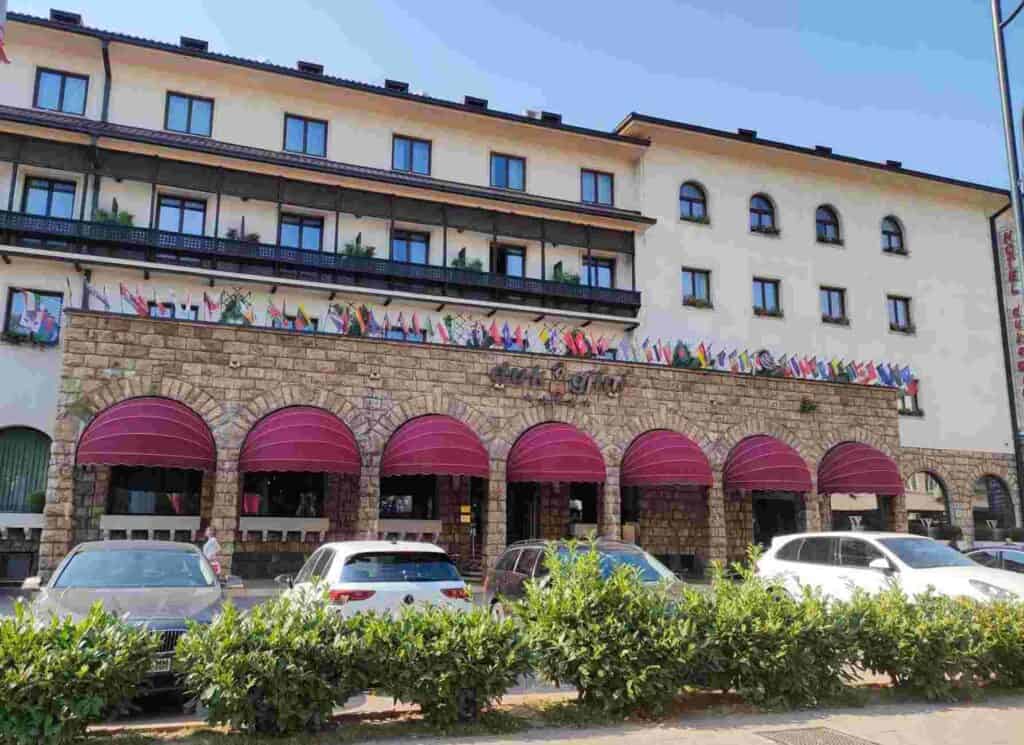
Regional Ethnological Museum of Peja
Outside the Ethnological Museum stands the statue of Haxhi Zeka (1832–1902), the famous Muslim cleric and nationalist activist who was the leader of the League of Peja, fighting for bigger autonomy within the Ottoman Empire.
Where to eat and drink?
Café Napoli Terraza, located on the top floor of a building, offers excellent views of the city and mountains.
Semitronix Centre has an enclosed glass bar on the roof
Prince Coffee House for a coffee
Restaurant Era – outside the city with a view
Where to sleep in Peja?
Rugova Gorge
One of Europe’s longest and deepest canyons, the Rugova Gorge, is the most beautiful landscape in Kosovo, and you have several options for visiting it, depending on your interest. The 25-km-long canyon stretches to the border with Montenegro and can be up to 1000 meters deep. The Lumbardhi i Pejës river cuts through the canyon, interrupted by natural pools that offer opportunities for swimming. All that makes it a center for outdoor activities.
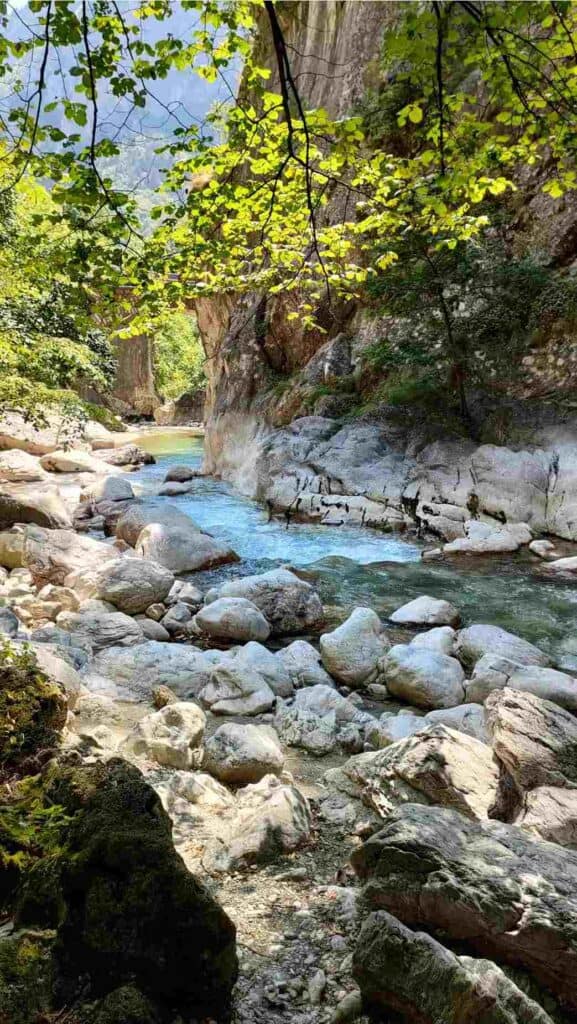
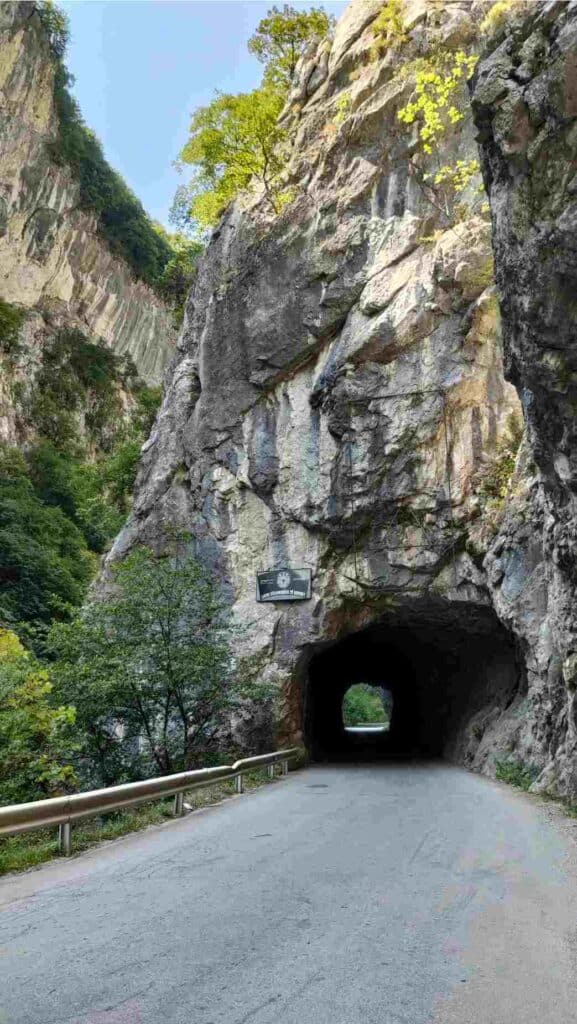
There are several ways to enjoy the scenery, depending on your interest.
1. Short and longer hikes
The best way to discover the Rugova Canyon is to go hiking. You can do shorter, some hours long hikes, a full day one or even multi-day hikes, and stay in one of the mountain villages. I don’t know much about the hiking trails as I was traveling with my baby son alone, so we couldn’t do that. But I inquired about what we could do at the entrance of the Rugova valley in the tourist center near the Pec Patriarchate. I highly recommend you go there directly, where they can explain more about the possible hikes and Via Ferrata.
If you don’t want or cannot do a longer hike like me, you can walk along the road from the monastery to the restaurant Lumi i bradhe, where there is even a small natural pool to swim in. You can continue walking to the “Rugova viewpoint” with a bridge crossing the Lumbardhi i Pejës (White River) with a great view. There is a small souvenir shop, and you can descend to the small restaurant close to the riverbank and enjoy the cool breeze in the hot summer months.
Here, you can get inspiration to hike one of the highest mountains of the Rugova Valley, Mount Hajla:
2. For adrenaline seekers, Rugova has the longest zip line in the Balkans
3. Drive your car and stop at several places along the way to Bogë
If you have a car, you can stop wherever you want. Stop along the river to swim and enjoy a meal, check the Rugova viewpoint, fly over the river with the zipline, complete the waterfall trail, and drive till Bogë.
Or, without any special activities, spend the day enjoying its scenery from the car and stopping at viewpoints while having a meal.
How to get to Rugova Valley from Peja if you don’t have a car?
Minibuses drive up and down between Peja and Bogë, the biggest city inside the Rugova Gorge, a popular ski resort. The bus leaves from the central bus station at 08.00 (also stops at the tourist information near the monastery at 8:10) and at 15.00 every day. It takes about 45 minutes to get to Bogë.
If you don’t have so much time and want to enjoy the scenery but don’t have a car, take the minibus to Bogë and return without getting off.
If you want to do some hiking, take the minibus in the early morning to Bogë, where you will find some hiking trails, and return with the one in the afternoon.
You can also take a taxi that is easy to find on the way too.
Mitrovica, the divided city of Kosovo
Mitrovica is the most troubled place in Kosovo, where ethnic tensions are still high. Since the war, Serbs and Albanians have lived separately on two sides of the river. The New Bridge connecting the two sides is the symbol of division. Apart from the modern Isa Beg mosque and the St. Demetrius Serbian Orthodox Church, there is not so much touristic attraction in Mitrovica. But it has a nightlife as vibrant as any other in Kosovo, and this is where you can get a much better understanding of Kosovo.
Read my detailed travel guide about Mitrovica
Adem Jashari Memorial Complex
Adem Jashari is the symbol of Kosovo’s independence, a national hero, not only for Kosovars but also for Albanians. He was one of the founders of KLA (Kosovo Liberation Army or UÇK), the Kosovo Albanian separatist movement that fought for the secession of Kosovo from the Federal Republic of Yugoslavia during the 1990s.
His importance is reflected in the number of establishments named after him, like the National Theatre, the Olympic Stadium, and the international airport in Pristina.
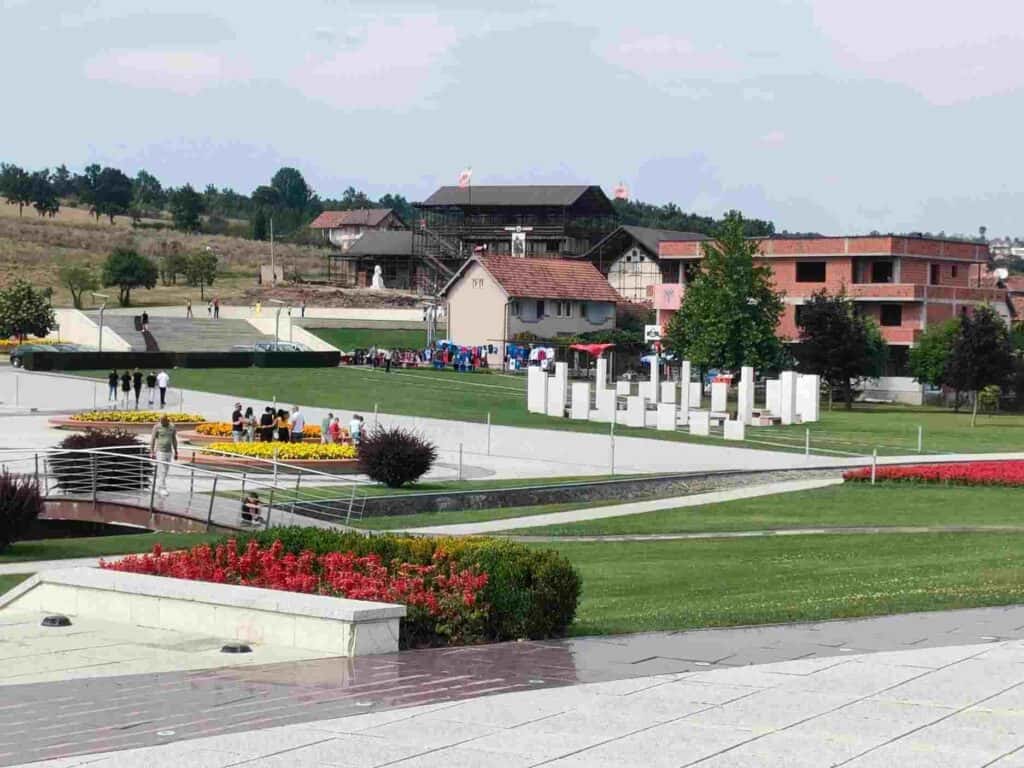
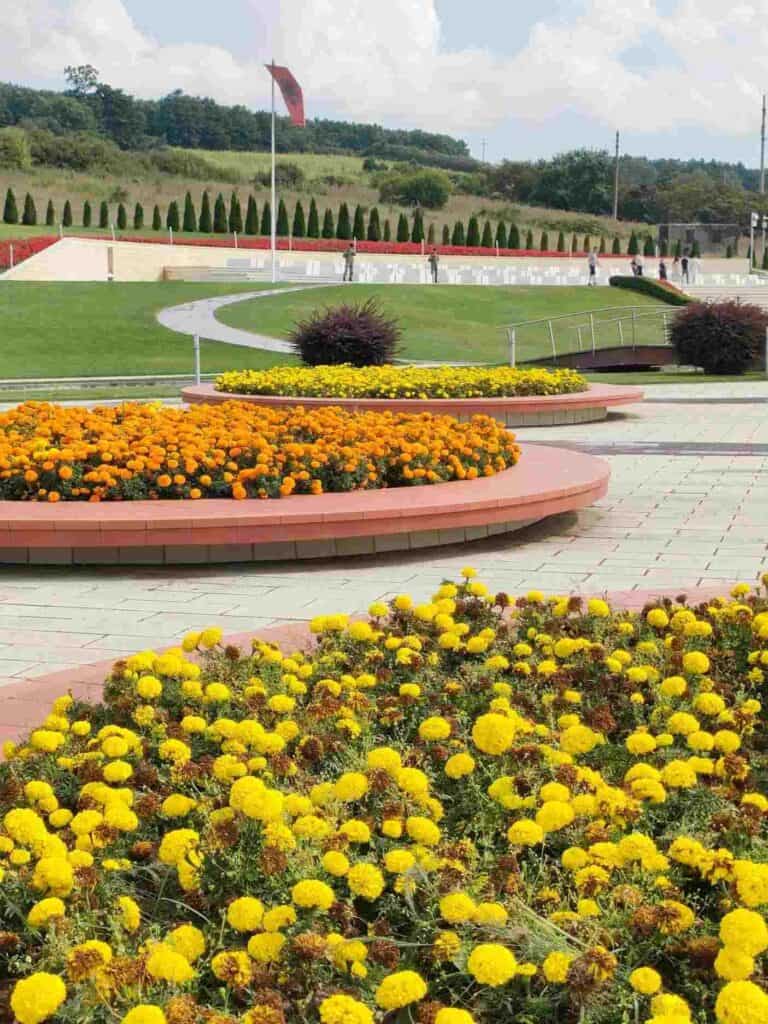
After Ademi had participated in several attacks against Serbian police, they finally attacked his house in Prekaz in March 1998. More than 50 people were killed, several children and women among them. As news about the killing spread, it pushed Albanians to join the KLA and take revenge for Ademi’s death.
His home has been transformed into a shrine and still bears the signs of the attack. Next to that, his and his family members’ graves are guarded by soldiers. The Jasharis are buried in the “field of peace,” where, in the early 1990s, rituals of reconciliation took place for families embroiled in blood feuds.
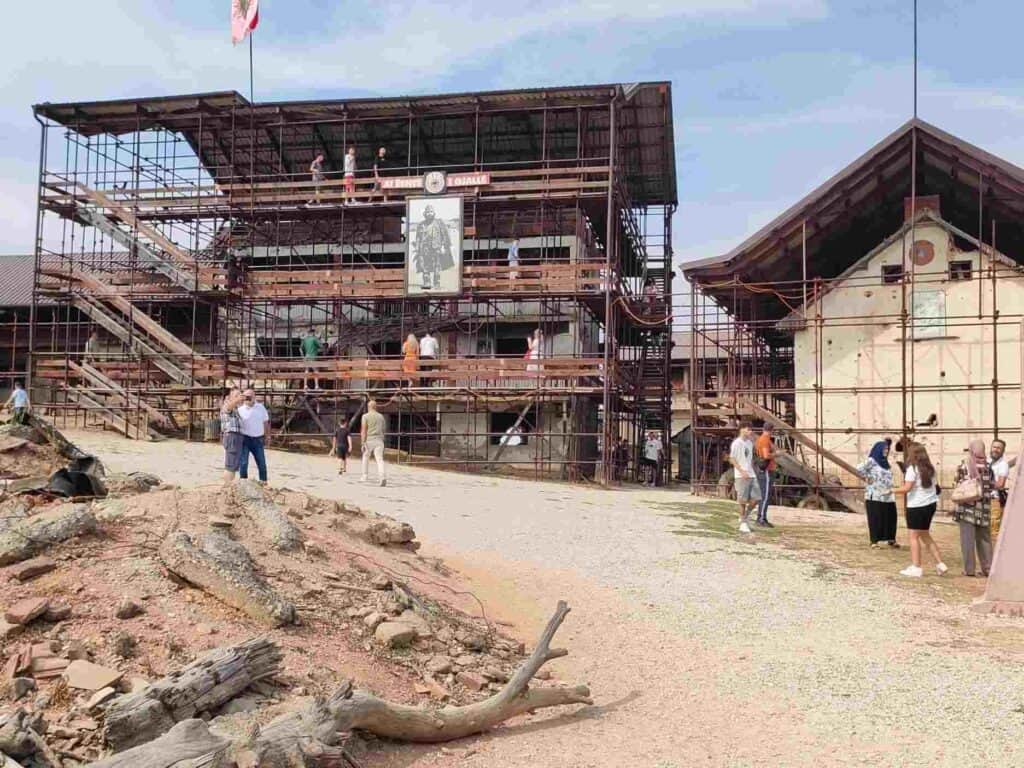
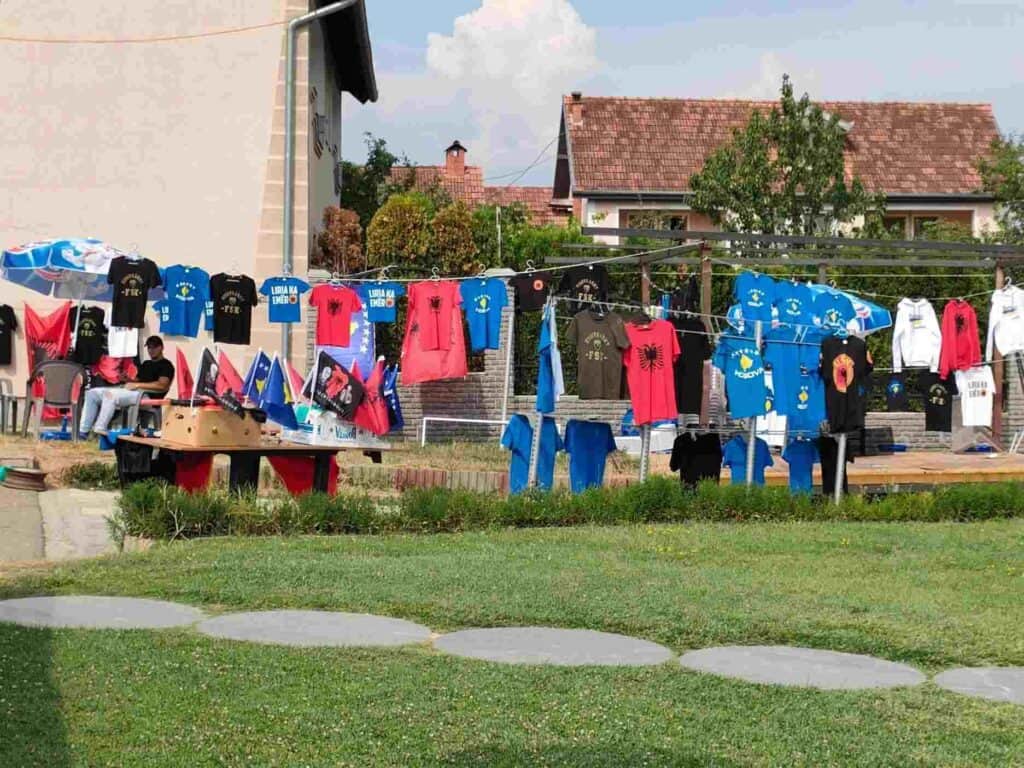
The souvenir shop at the Ademi complex sells everything from shirts and mugs about Kosovo’s independence.
Adem Jashari’s statue also stands in the center of Skanderaj, and the anniversary of his death is commemorated in Kosovo. They often compare Jashari’s role to the big Albanian hero, Skanderbeg.
This is the war’s most important memorial, considered a pilgrimage site for Kosovo Albanians.
How to get there?
There are regular buses from Mitrovica to Skanderaj (every hour). From the bus station of Skenderaj, it is a 20-minute walk to the complex located in Prekaz.
Rahovec
Rahovec is the center of wine production in Kosovo and a perfect place to taste Kosovo’s wine, which is becoming increasingly popular abroad. I visited the family-based Kosova Wine Winery, which possesses vineyards of 7 hectares, and I really liked it. However, the Stone Castle Vineyards & Winery is the most prominent winery. They have different tours that you need to book two days in advance. Opening hours: 10 AM and 4 PM by appointment only.
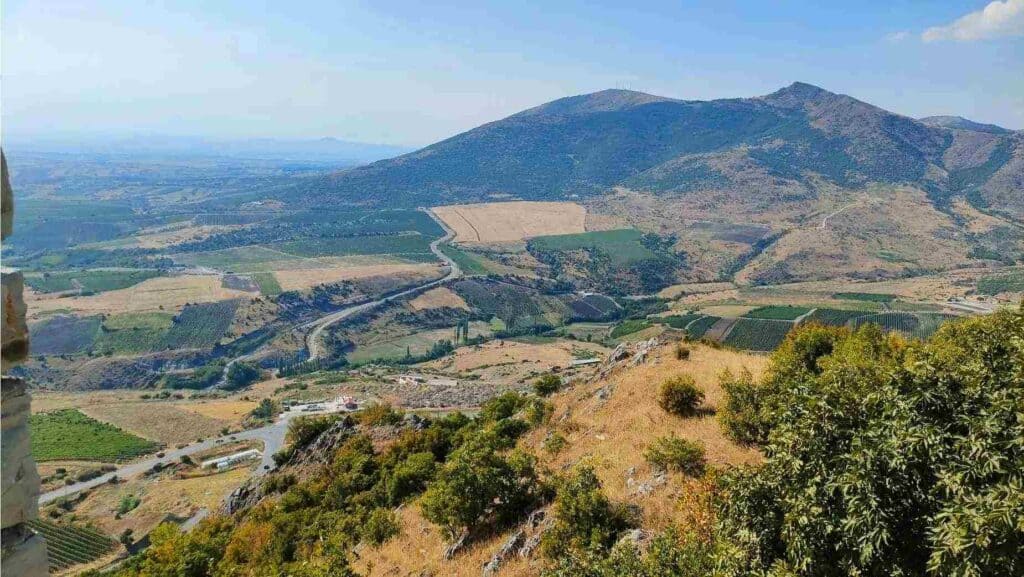
Even if you are not fond of wine, thanks to the vineyards, Rahovec has a beautiful hilly landscape you can enjoy the most from the Zatrič fortress. It is 20 20-minute drive from the center by car, but absolutely worth the visit. If you don’t mind climbing, a long flight of stairs leads up there, but to reach that point along the main road at the foot of the hill, you still need to go by car.
How to get there?
There are a couple of buses daily to Rahovec from Pristina and back.
Other posts about Kosovo
All you need to know about visiting Mitrovica
How to spend one day in Pristina
Other posts about the Balkan
Travel guide and itinerary (4 days, 5 days and one week) Bosnia and Hercegovina
What to do in one day in Mostar
Sarajevo travel guide + itinerary (1 day, 2 days and 3 days)
Kosovo is probably Europe’s least popular travel destination, mainly because of the lack of information. But Kosovo is an ideal budget travel destination, where you can enjoy the excellent nightlife and visit historic places and beautiful landscapes. Besides its stunning attractions, Kosovo will probably be the most memorable for the people’s outstanding hospitality. You also connect your visit to Kosovo with other neighboring countries in the Balkan, like Macedonia and Albania. This travel guide about Kosovo includes everything you need to know about things to do in Kosovo.

